February 27, 2020
A wonderful role debut for Natalya Romaniw in ENO's revival of Minghella's Madama Butterfly
Before a note is played, a geisha’s silhouette emerges into the breath-held silence, etched against a carmine sky. She glides and floats, her fans fluttering decorously, glinting in the golden sun. As she raises her arms, her kimono flickers, as transparent as a butterfly’s veined wing. Her obi trails behind her, a blood-red bridal train. Scooped up by four dancers, the sash sculpts curving geometries which twist about the geisha, confining, restraining. When, in the opera’s final moments, Cio-Cio-San re-enacts her father’s fate, her wedding obi becomes a silk wound, seeping and swirling, a bloodless emblem of betrayal and transcendence.
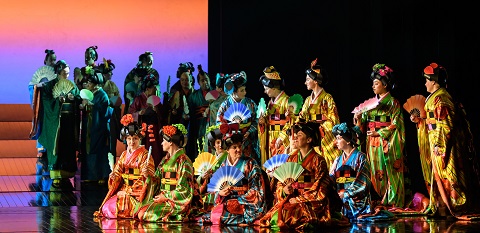 Photo credit: Jane Hobson.
Photo credit: Jane Hobson.
Peter Mumford’s lighting pits complementary hues in eye-dazzling combinations. The ‘visual banquet’ that I admired in 2013 seemed an even more intensely piercing colour-feast on this occasion. Han Feng’s costumes heighten the quasi-theatrical strangeness of the sense-saturating world in which Pinkerton finds himself seduced. Surfeit is balanced with simplicity, though: the beige shoji that slide noiselessly, like sleights of hand; the tendrils of cherry blossom that dangle tender pink against the black night sky.
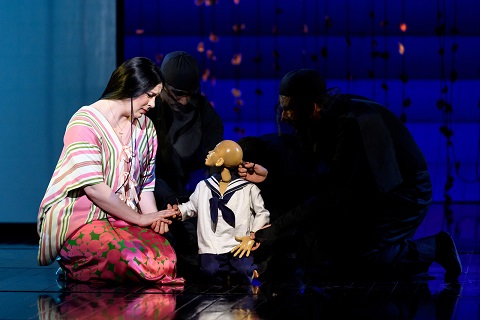 Natalya Romaniw and Blind Summit Theatre. Photo credit: Jane Hobson.
Natalya Romaniw and Blind Summit Theatre. Photo credit: Jane Hobson.
Then, there are the bunraku puppets, brought to life by the conjurer’s craft of members of Blind Summit Theatre. First time round, I’d found the puppets too stylised: a representation of the west’s ‘othering’ of the east. But, in 2016 I was won over by the truthfulness of the puppets’ uncanny realism, and here the mime-dance at the start of Act 2 Scene 2 foreshadowing Butterfly’s suicide was powerful and troubling. It was hard to believe that young Sorrow, dressed in a US Navy sailor-suit, rushing in stuttering steps to grasp his mother, tilting his head quizzically, proffering his hand to the saddened Sharpless, was not real.
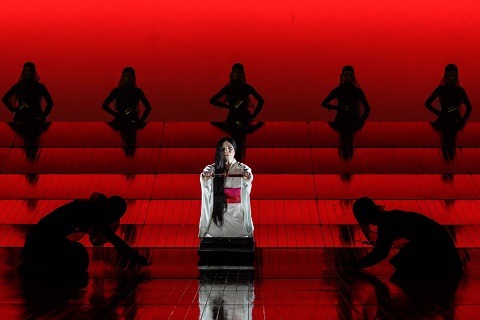 Natalya Romaniw. Photo credit: Jane Hobson.
Natalya Romaniw. Photo credit: Jane Hobson.
Singing her first Butterfly, Natalya Romaniw made a compelling entrance, the strong core at the heart of her shining soprano preceding her arrival at Goro’s marriage-brokering manoeuvres. Perhaps the creamy depths and heights of Romaniw’s soprano cannot quite capture the innocence of the fifteen-year-old ingenue, but the Welsh soprano worked hard to convey her naivety, and of Cio-Cio-San’s honour and pride, feistiness and gentleness, vivacity and vulnerability, there was no doubt. This Butterfly was bursting with a passion that she herself could barely know or understand. If I say that ‘Un bel dì vedremo’ brought I tear to my eye, I am not speaking figuratively. And, the ENO Orchestra, conducted by Martyn Brabbins, contributed greatly to the emotive power, so exquisite were the pianissimo gestures and textures. I had been underwhelmed by Brabbins’ approach in Act 1, but here understatement and delicacy were magically hypnotic, and thereafter there was more fire in the orchestral belly.
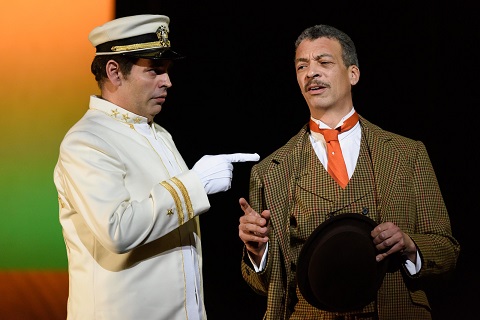 Dimitri Pittas and Roderick Williams. Photo credit: Jane Hobson.
Dimitri Pittas and Roderick Williams. Photo credit: Jane Hobson.
American tenor Dimitri Pittas, making his ENO debut, was a rather clamorous Pinkerton, struggling at the top and compensating for lyricism with volume. The effect was to make Pinkerton, at least initially, even more of a cardboard villain than usual; though, more effectively, it also made the US interloper even more of a stranger in this foreign land. By Act 3, this Pinkerton’s uncomprehending bewilderment was more moving than I had anticipated.
The other members of the cast were accomplished but did not make much of a mark, excepting Roderick Williams who, as Sharpless, was brow-beaten by Pittas’ barking in Act 1, but who sculpted a flesh-and-blood figure of persuasive empathy and sensitivity in Act 2, his lovely soft baritone infusing his exchanges with Butterfly with humanising kindness. Stephanie Windsor-Lewis was a reliable Suzuki but did not convey the fierceness of her loyalty and love for her mistress. Alasdair Elliott’s well-defined tone and clean enunciation skilfully captured Goro’s contemptuous condescension. Keel Watson was a thunderous Bonze, Njabulo Madlala a rather wobbly Yamadori. Katie Stephenson completed the cast as a somewhat tentative Kate Pinkerton.
This was Romaniw’s night. And, there surely will be many more such nights.
Madama Butterfly continues in repertory until 17th April.
Claire Seymour
Cio-Cio San - Natalya Romaniw, Pinkerton - Dimitri Pittas, Sharpless - Roderick Williams, Suzuki - Stephanie Windsor-Lewis, Goro - Alasdair Elliott, The Bonze - Keel Watson, Prince Yamadori - Njabulo Madlala, Kate Pinkerton - Katie Stevenson; Director - Anthony Minghella, Revival Director - Glen Sheppard, Conductor - Martyn Brabbins, Set Designer - Michael Levine, Lighting Designer - Peter Mumford, Costume Designer -Han Feng, Associate Director/Choreographer - Carolyn Choa, Revival Choreographer - David John, Puppetry - Blind Summit, Chorus and Orchestra of English National Opera.
English National Opera, London Coliseum; Wednesday 26th February 2020.
image=http://www.operatoday.com/MB%20ENO%20title%20image.jpg image_description= product=yes product_title=Madama Butterfly at English National Opera product_by=A review by Claire Seymour product_id=Above: Madama Butterfly, English National Opera
Photo credit: Jane Hobson
February 26, 2020
Charlie Parker’s Yardbird at Seattle
An assiduous scour through past reviews and You-Tube videos confirms that it has changed very little since it was reviewed for Opera Today at its opening by Andrew Moravcsik .
Curiously, its most detailed and analytical critique appeared in the official journal of jazz Downbeat, when that journal’s Chicago correspondent Howard Mandel reported on the two performances presented by Lyric Opera in its smaller Kimmel Theatre venue.
Or is it curious? Mandel was able to approach the piece from neutral ground, unconstrained by the burdens facing “classical” and “opera” reviewers covering a piece not only outside the standard repertory but outside in subject matter: the life and work of a hugely gifted drug-addicted black jazz improvisor who dreamed about fusing his art with mainstream classical music.
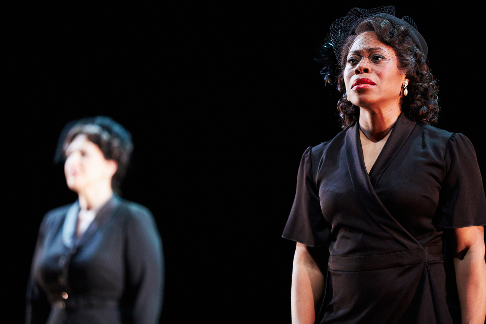 Chrystal E. Williams (Rebecca Parker)
Chrystal E. Williams (Rebecca Parker)
In his Downbeat write-up Mandel acutely analyses the components of composer Daniel Schnyder’s third-streamy amalgam of buried references to works by Parker and other jazz and classical composers, and the way that his busy, buzzy orchestration often blurs and distracts from his angular quasi-tonal vocal lines.
He doesn’t dwell on its effect on the singers and the audience. To penetrate the background instrumental muttering, the performers have to declaim every line, pedestrian or pompous; and since their material is undifferentiated and chanted at the same ponderous pace throughout, it soon ceases to have any particular emotional impact.
The thermostat is set at fraught. Each scenelet blurs into the next as the cast moves from one cafe table to another to denote the passage of time, forward and back. Dead at curtain’s rise, Parker revisits youth, fame, degradation, friendship, romance, only to end up on the same gurney they rolled him in on 90 intermissionless minutes before, while the remaining cast take turns mourning over him and the alto sax he brandishes from time to time but never plays.
The Seattle cast copes well with the material provided. The lights go on and off, the set goes up and down, time passes. The show ends. The compulsory standing ovation ensues. Curtain.
Roger Downey
Charlie Parker’s Yardbird : libretto by Bridgette A. Wimberly; music by Daniel Schnyder. Charlie Parker: Joshua Stewart/Frederick Ballentine; Addie Parker: Angela Brown; Rebecca Parker: Chrystal E. Williams; Doris Parker: Jennifer Cross; Chan Parker: Shelly Traverse; Dizzy Gillespie: Jorell Williams; Baroness Kathleen Annie Pannonica de Koenigswarter Rothschild: Audrey Babcock. Original stage director: Ron Daniels; Settings: Riccardo Hernandez; Costumes: Emily Rebholz; Lighting: Scott Zielinski; Choreoraphy: Donald Byrd; Sound design: Robertson Witmer. Members of the Seattle Symphony Orchestra, Kelly Kuo, conductor.
image=http://www.operatoday.com/200219_YardBird_DR_%201728.png image_description=Joshua Stewart (Charlie Parker) & Jorell Williams (Dizzy Gillespie). [Photo by Philip Newton] product=yes product_title=Charlie Parker’s Yardbird at Seattle product_by=A review by Roger Downey product_id=Above: Joshua Stewart (Charlie Parker) & Jorell Williams (Dizzy Gillespie).All photos by Philip Newton
February 25, 2020
La Périchole in Marseille
Then there is Patrice Munsel who re-created the role for soubrette soprano for the Metropolitan Opera’s grand opera version back in the 1950’s. Never to be forgotten is Maria Ewing’s delightful Périchole in San Francisco Opera’s spring season at the Curran Theatre back in the 1970’s. And of course Stephanie d’Oustrac who triumphed in the role at the Opéra de Marseille in 2002.
It is good news indeed that Marseille may have discovered a Périchole for a new generation. Already on her way to becoming an Offenbach diva mezzo soprano Héloīse Mas recently sang stage director Laurent Pelly’s bratty Boulotte (Barbe-Bleue) on the main stages in Lyon and Marseille. Just now Mlle. Mas found herself on the Opéra de Marseille’s second stage, the Théâtre de l’Odéon de Marseille (a 1928 cinema updated to an 800 seat “boulevard” style theater) for a somewhat reduced La Périchole.
Not that the Périchole of Mlle. Mas was in any way reduced. She approaches the mold of a larger than life diva, radiating a huge personality. It is a bonus that she is a fine singer who sang the role in big, warm and confident mezzo voice. This young artist (32 years old) may be capable of finding a far greater subtlety of character in this role than she projected, though she did create a charming, big-eyed mock innocence that all too often usurped the small stage.
Pedrillo was sung by tenor Samy Camps who brought everything needed to create Perichole’s easily duped, hapless lover. He is charming, young and fun and sings well. He has carved himself a career bringing new life to long forgotten Offenbach lovers in the Opéra de Marseille’s Offenbach Project, and to delighting France’s regional operetta audience in revivals of once famed works like composer Herzé and librettist Henri Meilhac’s comédie-vaudeville, Mam’zelle Nitouche.
The balace of the cast, notably the Viceroy sung by Olivier Grand and the Old Prisoner sung by Michel Delfaud, comes from the Opéra de Marseille’s (and the south of France’s) rich treasury of operetta and character singers.
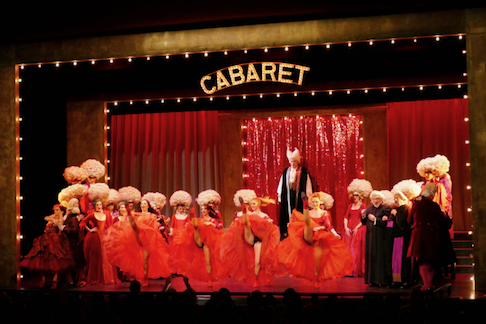 The Can-Can, with wigged chorus
The Can-Can, with wigged chorus
The production was staged by Marseille born Olivier Lepelletier. Mr. Lepelletier organized a minimal set that made the most of the minimal stage space of the Odéon, erecting four steps up across the back of the state, the center of which was a tiny, curtained proscenium opening, making the scene the cabaret of the three cousins. Minimal adjustments were made to create the second act palace (the chorus was sumptuously costumed) and the third act jail (a couple of benches downstage). Director/designer Lepelletier used the conceit of weird wigs that echoed a bit the idea of the exaggerated costuming of the 1868 Théâtre des Varietés production.
It was absolutely plenty to set the stage where Offenbach’s musical antics to the charmed antics of his famous librettists, Meilhac and Halévy triumphed without distraction. It was done with an orchestra of twenty players in the Odéon’s minimal pit. Conductor Bruno Membrey gave the accomplished performers everything they needed to show off their considerable personalities. It was the pure Offenbach at his minimal, maybe maximal, indeed very pleasurable best.
Mr. Lepelletier incorporated Offfenbach's 1874 version in so much as he could in his reduction of production requirements, modifying the narrative a bit in the first act to accommodate its placement in the cabaret, gently mocking the clergy as well.
Of great amusement were the four leg-some dancers, one of whom, Esméralda Albert, was the choreographer. They were the acrobats of the first act, the high kicking legs somehow avoiding a massacre of the chorus. They then became the guards who hustled Pedrillo and Périchole off to jail in jolly synchronized steps, a very charming moment.
It all climaxed in a rip roaring can-can à la Moulin Rouge, with the contortionist dancer, Adonis Kosmadakis, joining the four propelled danseuses to blow us away (it's hard to see the legs in the photo, but they're there).
Michael Milenski
Cast and production information:
La Périchole: Héloïse Mas; 1ère Cousine / Guadalena: Kathia Blas; 2ème Cousine / Berginella Lorrie Garcia; 3ème Cousine / Mastrilla: Marie Pons; Piquillo Samy Camps; Vice-Roi Olivier Grand; Panatellas Jacques Lemaire; Hinoyosa Éric Vignau; Tarapote / Un Notaire Antoine Bonelli; Le Vieux Prisonnier / Un Notaire Michel Delfaud. Chœur Phocéen; Orchestre de l’Odéon. Direction musicale Bruno Membrey; Mise en scène Olivier Lepelletier;
Chorégraphe Esméralda Albert. Théâtre de l’Odéon de Marseille, February 23, 2020.
image=http://www.operatoday.com/Perichole_Marseille3.png
image_description=Photo by Christian Dresse courtesy of the Opéra de Marseille
product=yes
product_title=La Périchole in Marseille
product_by=A review by Michael Milenski
product_id=Above: Samy Camps as Pedrillo, Héloīse Mas as Périchole
Photos by Christian Dresse courtesy of the Opéra de Marseille
February 23, 2020
Three Centuries Collide: Widmann, Ravel and Beethoven
We began this journey through time in 2003 with Jörg Widmann’s Lied for Orchestra. This is a piece centred on melody - and centred on Schubert. It is a work of profound extremes, with an orchestra that is like a Schubert lieder but without being the accompaniment to it. The tenor of the music is indeed more resonant of Schubert than Widmann’s style normally suggests, and if there is a focus on song in this piece it is generated by the orchestra responding to the intimacy of the instrumentation of a piece like the Octet with instruments characterised by instrumental solos replicating their orchestral voices. But, what is also noticeable is what is not Schubert. The debt to Sibelius - especially that composer’s Seventh Symphony - shines like a floodlight. Even more apparent is Mahler’s Tenth Symphony, especially the final movement. The use of the bassoon suggests all its lugubriousness, but it’s the intensity of the string writing, the swelling violins and dark strings which seem just as searing in that movement’s terrifying climax; a trio of trombones has all the effect of overloaded power, the crushing percussion a hammer blow. The work may travel through styles but it’s musically effective and the London Philharmonic played it superbly.
Wind back a century to 1903 and we were in the world of evocative song and ravishing orchestration - Ravel’s Shéhérazade. This was, in many ways, not an ideal performance but Ravel does not make life particularly easy for any mezzo who attempts to sing the part. Christine Rice lacked a certain precision in her French which was magnified, certainly by this particular orchestra. When Juliette Bausor’s principal flute sounded so impeccably shaped, with a tone exquisitely given to stretch her lines into infinity, Rice’s clipping of phrases and tendency to muzzle the distinctive clarity of what she was singing came across as less than accurate.
But that is not to say that her voice itself is often a beautiful instrument. Its very depth and sheen can often give the impression of conveying mystery, although what we got was principally an illusion of it. That long first song, ‘Asie’, should be a melding of two worlds - one of beauty the other of horror; but listening to Rice’s version I’m not sure I got this. There didn’t seem much of either mystery or solitariness in the line “Mystérieuse et solitaire”, nor the distinction between “des rose et du sang” towards the songs close. The panache of the London Philharmonic’s Spanish-inflected rhythms, its oriental shades of Eastern promise were highly expressive but simply highlighted the struggle many singers experience in this cycle.
There are difficulties in the two shorter songs, though I think Rice managed them slightly better. ‘La flute enchantée’ needs to strike a balance between sorrow and joy and that is largely what we got with Rice able to bring a mellowness and sense of radiance to her voice. ‘L’indifférent’ is complex in that it can take a mezzo outside her comfort zone - some find the characterisation of its androgyny difficult to navigate; others embrace it. Rice leaned towards the latter, but principally because the voice’s darker more masculine tones hinted at her ambiguity.
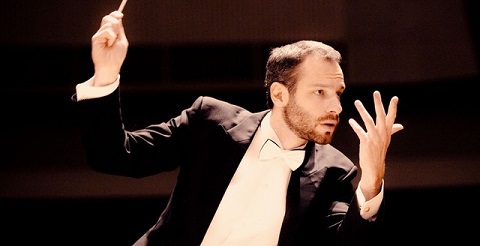 Dima Slobodeniouk. Photo credit: Marco Borggreve.
Dima Slobodeniouk. Photo credit: Marco Borggreve.
The concert ended in 1803, as it were, with Beethoven’s Eroica. Despite this symphony being an indisputable masterpiece, it never surprises me how many performances of it hang fire. This, however, was one of the most incendiary I have heard in many, many years. I have yet to mention the conductor of this concert, Dima Slobodeniouk. He is not the most precise conductor I have seen, but what he does do is shape what he conducts with great integrity and vision. The gestures are broad in scope as he sweeps his left hand deep into the orchestra. But what is most impressive is that magical illusion of making what he conducts seem much faster than it actually is. The Allegro con brio of this Eroica sounded quite measured but the sheer electricity generated was absolutely thrilling. There was no broadness in those opening chords, so I suppose one might have expected a certain fleetness - but it wasn’t immediately apparent we would get it.
The Marcia Funebre, on the other hand, seemed to work in the opposite direction. This was fast, and there was never any sense it was otherwise. Perhaps the F minor Fugue didn’t quite have sufficient power for my taste, but Slobodeniouk managed to pull some depth from the LPO’s cellos and basses which did at least suggest gravity and that plunge into the turbulent and ferocious development was a thrilling cataclysm of despair. I think one might have preferred divided violins and a different layout of lower strings, but we had what we had.
The brilliance of this performance’s Scherzo was entirely down to the lightness of touch from the orchestra, something which was carried through to the Allegro molto - its storms, fugues, sforzandos and wildly fluctuating dynamics articulated with uncompromising brilliance. A revelatory performance, and one which bookended an often fascinating concert.
Marc Bridle
Christine Rice (mezzo-soprano), Dima Slobodeniouk (conductor), London Philharmonic Orchestra
Royal Festival Hall, London; Saturday 22nd February 2020.
image=http://www.operatoday.com/Christine-Rice-4bw-c-Patricia-Taylor-WEB%20%281%29.jpg image_description= product=yes product_title=Dima Slobodeniouk conducts the London Philharmonic Orchestra at the Royal Festival Hall product_by=A review by Marc Bridle product_id=Above: Christine RicePhoto credit: Patricia Taylor
Seventeenth-century rhetoric from The Sixteen at Wigmore Hall
Published in 1593, Henry Peacham’s The Compleat Gentleman reminds us of one of fundamental philosophical and cultural tenets of the Elizabethan age: the close, perhaps inextricable, relationship which was held to exist between the art of music and the art of spoken rhetoric. And, it was that bond of music and word - which composers exploited to ‘move’ the listener by cultivating grief, melancholy, joy and faith - that this programme of music presented by The Sixteen at Wigmore Hall was designed to reflect.
But, the self-conscious rhetoric of the lute ayre, with its quasi-metaphysical tensions and its strange intensity and elusiveness, is quite a different thing from the nature of the musico-poetic relationship that we see William Byrd crafting in his 1611 collection, Psalmes, Songs and Sonnets. When Byrd declares his music as being ‘framed to the life of the words’ he does not mean that his songs are a musical embodiment of a poem’s central conceits, such as we find in John Dowland’s 1612 collection, A Pilgrimes Solace. Byrd is concerned not with elusiveness but with clarity; his music reinforces the formal contours of the poetry which thereby acquires a rhetorical force so that the listener may appreciate its meaning more directly and powerfully. The Sixteen, led by their conductor Harry Christophers, proved more comfortable exploring Byrd’s expressive formal rhetoric and madrigalian detail than Dowland’s illusive tropes and dialectic.
The items by Dowland offered individual singers an opportunity to step from the ensemble and perform as soloists, accompanied by lutenist David Miller. Soprano Katy Hills sang ‘Disdain me still’ with directness, purity of tone and some attentiveness to the words, but her delivery lacked the flexibility required to convey the erotic tension of the text which opposes desire’s fulfilment with its self-destruction: “Disdain me still, that I may ever love”, begins the poet-singer, concluding, “Love surfeits with reward, his nurse is scorn”.
These songs require considerable performative presence. Perhaps the presence on the platform of the other singers and Christophers, the latter perched on a high stool, was inimical to the recreation of the intimate context for which these courtly songs - intended for a specific, intellectually sophisticated and socially elevated status - were composed. That said, the ensemble was necessary for the choric conclusions to ‘Welcome black night’ and ‘Cease these false sports’, which suggest that these songs were performed within a masque or similar entertainment. The florid melismas of the latter were elegantly sung by bass Ben Davies, although he did not communicate the nuances and inferences of the text, which he articulated clearly, as the poet-speaker bids “Goodnight” to his “yet virgin bride”. Jeremy Budd’s tenor was fittingly light and buoyant in ‘Up merry mates’, though in characteristically melancholy fashion, Dowland concludes with a minor-key choral lament, “A dismal hours,/ Who can forbear,/ But sink with sad despair.”
Alexandra Kidgell revealed the richly colour lower register of her soprano at the start of ‘In darkness let me dwell’, but she seemed uncertain how to negotiate the irregularity of Dowland’s phrase structures and his inventive approach to text setting which capture the idealisation of sorrow and death in these elegiac ayres, embodying as they do the notion of inexpressibility and the dissimulation, concealment and ambivalence which are the essence of the courtly pose.
The stillness and serenity of soprano Julie Cooper’s performance of ‘Sweet stay awhile’ was compelling, and bass Eamonn Dougan made much of the repetition of the final couplet of ‘Shall I strive with words to move’: “I wooed her, I loved her, and none but her admire./ O come dear joy, and answer my desire.” Here there was a real sense of human complexity, contradiction and desire. The Dowland songs were accompanied in a rather restrained manner by Miller, tasteful and no doubt idiomatic, but with little sense of the mercurial and ‘strange’ that more elaborate renditions may intimate. Miller and tenor Mark Dobell had the stage to themselves for a sequence of three songs, ‘Thou Mighty God’, ‘When David’s Life by Saul’ and ‘When the poor cripple’. Dobell’s soft even tone was apparent from the first unaccompanied “Thou”, and the vocal line was well-focused as it twisted through the chromatic contortions and the aching repetitions of “misery and pain”.
The members of The Sixteen seemed more comfortable singing as an ensemble, and the idiom of William Byrd’s Psalmes, Songs and Sonnets, ‘Some solemne, others ioyfull, framed to the life of the words: fit for voyces or viols of 3.4.5. and 6. parts’, is a natural fit for Christophers’ approach to words, rhythmic form and temporal expression.
There was a gradual heightening of intensity in the opening ‘Retire, my soul’, while the ever denser textures of ‘Come woeful Orpheus’ were beautifully strengthened by the eloquence of the middle voices, culminating in the urgent chromaticism of the closing appeal: “Of sourest sharps and uncouth flats make choice,/ And I’ll thereto compassionate my voice.” A ‘wiry’ nimbleness characterised ‘Come, let us rejoice unto the Lord’ and this energy swept through and beyond the final phrase, Christophers briskly snatching away the concluding avowal, “in psalms let us make joy to him”. The way Byrd’s uses formal rhetoric to communicate verbal, often moral, meaning was well-illustrated at the close of ‘Arise Lord into thy rest’, the melismatic ‘leans’ of “Let the priests be clothed with justice ” being sharply superseded by the staccato dance, “And let the saints rejoice”.
I found some of the lighter lyrics presented in the second half - ‘Sing we merrily’, ‘Come jolly swains’ - a trifle too tinged with the diction and tone colour of the English cathedral school tradition; but, ‘This sweet and merry month of May’ had lovely flexibility, the triple-time “pleasure of the joyful time”, giving way to the expansive awe and adulation of “ O beauteous Queen”, before a celebratory surge to the close. The “Amen” at the end of ‘Praise our Lord all ye Gentiles’ was warm and florid, opening its petals like a budding flower releasing its scents and welcoming the sunlight. Some of the ensemble songs were accompanied by Miller but, at least from my seat at the rear of Wigmore Hall, the lute was practically inaudible.
‘This day Christ was born’ had made for a buoyant conclusion to the first half of the concert, “rejoice” blossoming melismatically before a majestic “Glory be to God on high” was answered by a triple-time “Alleluia”. Christophers manoeuvred the structural and temporal shifts with masterful control and ease. Similarly, the seamless polyphony of the final item of the concert, ‘Turn our captivity, O Lord’, built persuasively towards the confident assertion, “they shall come with joy”, and the broad assurance, “carrying their sheaves with them”.
Claire Seymour
The Sixteen: Harry Christophers (conductor)
Byrd - ‘Retire my soul’; Dowland - ‘Disdain me still, that I may ever love’; Byrd - ‘Come woeful Orpheus’; Dowland - ‘Welcome black night/Cease these false sports’; Byrd - ‘Come, let us rejoice unto our Lord’, ‘How vain the toils’, ‘Arise Lord into thy rest’; Dowland - ‘Thou mighty God’; Byrd -‘Make ye joy to God’, ‘This day Christ was born’, ‘Sing we merrily’; Dowland - ‘In darkness let me dwell’; Byrd - ‘Come jolly swains’; Dowland - ‘Up merry mates’; Byrd - ‘Crowned with flowers and lilies’; Dowland - ‘Sweet stay awhile’; Byrd - ‘This sweet and merry month of May’; Dowland - Preludium, ‘The Frog Galliard’; Byrd - ‘Praise our Lord, all ye Gentiles’; Dowland - ‘Shall I strive with words to move’; Byrd - ‘Turn our captivity, O Lord’
Wigmore Hall, London; Friday 21st February 2020.
image=http://www.operatoday.com/Harry%20Christophers%20High%20Res%202%20-%20credit%20Marco%20Borggreve.jpg image_description= product=yes product_title=The Sixteen sing Dowland and Byrd at Wigmore Hall product_by=A review by Claire Seymour product_id=Above: Harry ChristophersPhoto credit: Marco Borggreve
Hrůša’s Mahler: A Resurrection from the Golden Age
There was, it should be said, nothing intimate about Hrůša’s opening bars;
the abundance of dynamic power here was terrifying and yet it was played
with a gripping conviction and intensity which would be a hallmark of this
performance. There are performances of Mahler’s Resurrection which
lapse - rather quickly, and all too commonly - into fragments. This was not
one of them. Hrůša does see contrasts in the first movement, but they
aren’t noticeably extreme. We never got a heavy-handed treatment of the
woodwind during their first theme; their rhythms were pointed and
eloquently sketched rather than chiselled into stone. That Hrůša was able
to take this vast movement in one long sweep never concealed the urgency or
dramatic intensity of the furious and wild ride he and the orchestra took
us on.
It was the second movement’s Andante which demonstrated either
considerable preparation for this performance, or just a symbiosis of
vision between the conductor and orchestra. Whichever it was, it was simply
remarkable. I have rarely encountered this movement performed with such
delicacy or care for its inner details; hanging on each note but with such
fluidity - but then Hrůša’s Czech background takes us very close to the
Mahlerian roots of Austrian Ländler and waltzes where these things matter.
Woodwind solos weren’t just phrased like mini dramas, each individual
instrument was like the dramatis personae in a play; it was crystal clear
what each instrument was doing (the chamber music quality of this
performance) and you never questioned even the smallest details. The
pizzicato section had no unexplained deviations; and you knew exactly
whether the harp was playing an arpeggio or otherwise.
Hrůša’s Scherzo lacked none of the fear or horror which he had
brought to the first movement. One often wondered from what hell the
resonating and thundering timpani came from; but they were the support or
markers for a tempo which had a swiftness that was electrifying. Hrůša is
not a conductor to feel the fear of Mahler’s pianissimos - we got it during
the main subject here. The lingering, evocative, bassoon of Emily Hultman
appeared like a spectral presence through the undergrowth of the orchestra,
just as a fluttering trio of flutes wavered and floated above the
Philharmonia’s gutsy strings. Brass were so precise they seemed like
soldiers marching in unison.
Urlicht
really was uncommonly rapt here, perhaps a surprise given how powerful the
first three movements of the symphony had largely been. Hrůša didn’t so
much take the orchestra into quieter territory but pulled them down like a
force of nature. I think it made Jennifer Johnston all the more sumptuous
because of that, her voice seeming just a little larger than life and we
usually experience in this movement. The darkness of her tone, those plump
lower notes with a beautifully supported upper range which floated
exquisitely mirrored so much of what Hrůša had been doing with the
orchestra. That depth in Johnston’s bottom register was articulated on the
lower strings; she was always involving, the Philharmonia never elementary.
After such rapture the outburst to the final movement seemed shocking.
Hrůša held nothing back, unleashing the Philharmonia with such power it
felt like the prelude to an execution. You sometimes sense fatigue in
orchestras during this vast monument - here, if anything, the Philharmonia
were driven by its ferocity, inspired by Hrůša’s vision of its immensity
and scale but also of its visceral, juggernaut-like drive. The Royal
Festival Hall is often criticized for its acoustic but in such large-scale
works as Mahler’s Resurrection this hall works to its advantage.
This was particularly the case during the off-stage bands, those eccentric,
even malevolent, distractions. Here they felt like rapid, intoxicated and
riotous interludes, although just occasionally one felt that Hrůša brought
such power to the orchestra they were simply overwhelmed. But off-stage
trumpets were magnificent and as sharp as knives in their accuracy.
The soprano Camilla Tilling did not start her first entry well, sounding
both underpowered and very uncertain as to whether her voice would stretch
to its required range. The first entry of the chorus - on such a diminished pianissimo - was ravishing, audible enough, but one almost had to
strain to hear them. If Johnston had the power to rise above the orchestra,
Tilling still struggled somewhat, not always helped by a variable vibrato
which strained rather than helped her voice. I’m not really sure they gave
the most balanced of duets I have ever heard in this symphony either. It
was only really before the chorus’s forte entry that Tilling
finally assumed some power but it felt too late. And the chorus were
magnificent, even cataclysmic, the clarity of the diction almost irrelevant
given the sheer scale of its climax. Hrůša brought that final orchestral
peroration to a close with its breadth of emphasis rather than the usual
clipping of the phrase.
This had been a superlative Mahler Resurrection, a gripping
performance in an age where it is rare to experience Mahler of this
quality.
Marc Bridle
Camilla Tilling (soprano), Jennifer Johnston (mezzo-soprano), Jakub Hrůša
(conductor), Philharmonia Chorus, Philharmonia Orchestra
Royal Festival Hall, London; Thursday 20th February 2020.
image=http://www.operatoday.com/Jennifer%20Johnston%20%C2%A9%20R%20T%20Dunphy.jpg image_description= product=yes product_title=Mahler: Symphony No.2 (Resurrection) product_by=A review by Marc Bridle product_id=Above: Jennifer JohnstonPhoto credit: R.T. Dunphy
February 20, 2020
Full-Throated Troubador Serenades San José
A wagging singsong parody of the knotty plot begins with “I’ll tell you the story of Il Trovtore.” One reason for the difficulty in following the nefarious machinations is that most of the all-important set-up has happened off stage, well before the opera’s story ever begins. So, it behooves audiences to pay particularly close attention to the Surtitles during the opening scene when the rivalry for Leonora between Manrico and the Count di Luna is explained, the introduction to the trials of the gypsy woman Azucena is laid out, along with the suggestion of a terrible secret.
Brad Dalton has chosen to stage a pantomime during the opening bars that establishes di Luna’s unholy lust for Leonora and her understandable revulsion. Mr. Dalton has staged a non-fussy, straightforward account that was admirable for its clarity and control. Stage pictures were clean and varied, although they (only) occasionally suffered from a bit of stasis.
If the characters were longer on potent vocal delivery than they were on richly detailed interaction, that is not entirely the responsibility of the director. Mr. Dalton managed to infuse sufficient life in the sometimes illogical twists and turns of Cammarano’s routine libretto to make it understandable and engaging. He even provided some compelling novel touches like having an emboldened Leonora pair with her Manrico at the close of Act I by brandishing a broadsword as if to the mission born.
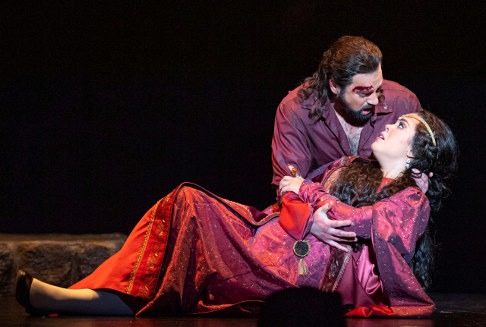 Manrico (Mackenzie Gotcher) comforting his true love, Leonora (Kerriann Otaño).
Manrico (Mackenzie Gotcher) comforting his true love, Leonora (Kerriann Otaño).
Much of OSJ’s marketing of this feature furthers a Game of Thrones dynamic, banking on that enormously popular show to help sell tickets to new audiences. The association is not misplaced, since power playing is what drives the plot. In epic fashion, the ubiquitous sword is passed and paraded ceremoniously from scene to scene, and what a satisfying scene design it is.
Steven Kemp has devised a winning variation on the “unit setting” concept, framing the space with brick legs and tormentors that not only convey imposing structures when required, but also literally frame the action with handsome detail. Within this basic look, Mr. Kemp moves about stylish steps, anvils, ramps, anvils, and well-selected set pieces that are backed by a distressed backdrop that sports a jagged rounded hole, like the outline of an oozing planet, up left.
Michael Palumbo has lit the proceedings with aplomb and colorful imagination, capitalizing on many different variations of the exclusively nighttime action of the piece. Mr. Palumbo’s areas and specials were all moody evocations of the tortured progression of the characters’ journeys. Curiously, the glow of the oncoming dawn in Act II receded to shadows for the powerful Azucena-Manrico exchange, murkily effective, but not exactly how dawn works.
Elizabeth Poindexter’s sumptuous, abundant array of costumes not only delighted the eye but also commendably informed the station of the characters. Ms. Poindexter was ably abetted by Dave Maier’s telling wig and make-up design, which complemented the historical fantasy concept. I might have wished for a more eccentric, troubled, gypsy look for Azucena, but I respect the committed decisions the team made.
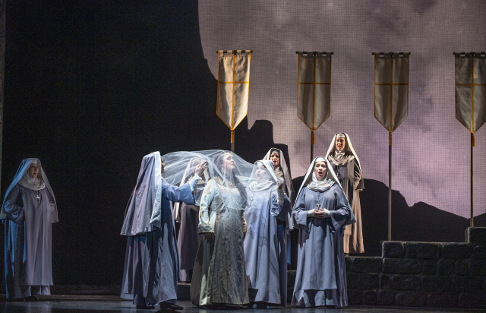 Leonora (Kerriann Otaño) who, believing her love has died, prepares to take the veil and enter a convent.
Leonora (Kerriann Otaño) who, believing her love has died, prepares to take the veil and enter a convent.
Enrico Caruso famously quipped the “all you need for a successful production (of this opus) is the four best singers in the world.” Even the world’s major houses are challenged to meet the starry demands of Il Trovatore, but if you want to know who the next major international proponents of these roles will likely be, you need not look much further than the skillful assemblage on stage at the California Theatre.
It is called The Troubador after all, and Mackenizie Gotcher was simply tremendous in the titular assignment. Mr. Gotcher is perfectly equipped to excel in the challenging role of Manrico, with his strapping good looks, ringing heavy lyric tenor, and consummate musicality. There is no aspect of this daunting assignment that eludes him, be it the stentorian thrills of “Di quell pira,” the honeyed sentiments of “Ah! si ben mio,” or the gripping exchanges with Azucena.
Gotcher has true squillo in his sizable instrument, and he lavishes Verdi’s potent writing with personality and deeply felt emotions. The road ahead seems bright indeed for this polished, poised performer. His star turn alone is worth the price of admission. Happily, he is in good company.
Mezzo Daryl Freedman is on her way to becoming a force of nature in the Zajik mold with her powerful, knowing interpretation of the willful Azucena. Ms. Freedman’s well-schooled instrument was even from top to bottom, and she knows how to knit her registers with consummate skill. With a rich, ripe middle range, a searing, pliable top, and round, booming chest tones, this treasurable vocalist found every variation of intensity in the opera’s most complex role. I hope that future outings will find this gifted interpreter delving even deeper into the dramatic subtext.
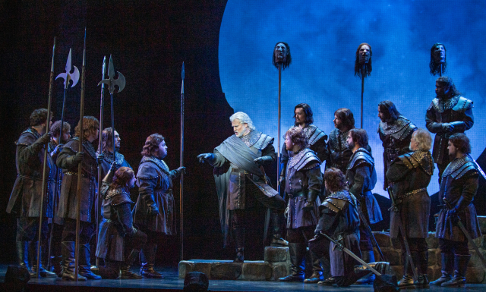 Ferrando (Nathan Stark) ordering his men to keep watch.
Ferrando (Nathan Stark) ordering his men to keep watch.
Eugene Brancoveanu is a mellifluous, malevolent Count di Luna. His baritone is a marvel of tonal beauty, buzzing with virility, and eminently flexible. Mr. Brancoveanu invests the many repetitive confrontational declamations with admirable delineation, and he avoids the trap of barking the accented scale and arpeggiated passages. He displays enviable ease in the upper reaches of the part and finds some welcome brighter swings in the Count’s mostly dark intentions.
I only wish that this fine singer could find a bit more breath control for the Bellinian stretches of his character-defining aria, for I found that his choppy phrasing and snatched breaths somewhat defeated the beauty of the long-drawn lines of “Il balen.” Most everywhere else he excelled, no more so than in the well calibrated last act duet with Leonora, the accomplished performer Kerriann Otaño.
Ms. Otaño’s warmly radiant, substantial soprano was a lovely complement to the roster. Her Verdian sense of line and her deeply experienced, conflicted feelings were manifest in a role traversal that was long on beautifully modulated tone and knowing generosity of utterance.
Like many a famous interpreter of this difficult assignment, once past the pitfalls of successfully negotiating “Tacea la note placida” and its angular cabaletta, the soprano relaxed into a luxuriant outpouring of sound and sentiment that dominated her every appearance. Her defiant, armed stance against Manrico’s opponents spoke volumes about the depth of her theatrical resolve.
Although Caruso addressed the demands for the four principals, there is a fifth requirement for a fine Trovatore, namely Ferrando, who has the unenviable job of setting up the whole unlikely scenario in his lengthy opening appearance. Luckily, local favorite Nathan Stark conquered in that daunting responsibility, and he delivered in spades, with a potent and pointed delivery of “Di due figli.”
Mr. Stark has a sizable, pliable bass-baritone that limns the tale of two rival brothers with tragic urgency. Moreover, he commands the stage with a winning presence and cunning command of nuance. It is not often that you will encounter this opening scene invested with such artistry and dramatic interest. He is greatly assisted in his efforts by the excellent exclamations from Christopher James Ray’s well-tutored chorus, who were outstanding all evening long.
A final vital component in the evening’s success was Joseph Marcheso’s conducting of a responsive and highly skilled orchestra. Maestro Marcheso displayed full command of this almost bare bones structure of the middle Verdi canon, and he managed to invest the repetitive bass-chord-bass-chord progressions with meaningful forward motion. He also partnered his vocalists with consummate collaborative effort, even though the soloists sometimes lagged just a bit behind the beat in more urgently rapid passages.
At the end of the night, the excitable opening night audience was clearly delighted with the riveting music making and lavished the performers and creative team with a vociferous appreciation. This winning mounting of Il Trovatore is not only top professional quality, but it is also excellent entertainment value at Opera San Jose’s reasonable pricing. Come to the California theatre early and you may also get treated to a pre-show pops recital on the historic organ in the atmospheric lobby.
James Sohre
Il Trovatore
Music by Giuseppe Verdi
Libretto by Salvadore Cammarano
Leonora: Kerriann Otaño; Manrico: Mackenzie Gotcher; Count di Luna: Eugene Brancoveanu; Ferrando: Nathan Stark; Azucena: Daryl Freedman; Inez: Stephanie Sanchez; Ruiz: Mason Gates; Old Roma: Glenn Louis Healy; Messenger: Nicolas T. Gerst; Conductor: Joseph Marcheso; Director: Brad Dalton; Set Design: Steven Kemp; Costume Design: Elizabeth Poindexter; Lighting Design: Michael Palumbo; Fight Choreography: Dave Maier; Wig and Make-up Design: Christina Martin; Chorus Master: Christopher James Ray.
image=http://www.operatoday.com/Il-trovatore_David-Allen_6-scaled.png image_description=Azucena, (Daryl Freedman) describing to Manrico (Mackenzie Gotcher) her most tragic misdeed. [Photo by David Allen courtesy of Opera San José] product=yes product_title=Full-Throated Troubador Serenades San Jose product_by=A review by James Sohre product_id=Above: Azucena (Daryl Freedman) describing to Manrico (Mackenzie Gotcher) her most tragic misdeed.All photos by David Allen courtesy of Opera San José
February 19, 2020
Opera North deliver a chilling Turn of the Screw
Ambiguity lies at the heart of Henry James’s ghost story, a tale that’s grist to the mill for imaginative directors, especially those willing to add new layers of suggestion. James’s novella is far more than the blurred lines arising from the presence of ghostly apparitions (made explicit here) or the absence of moral absolutes. It’s a world of half lights and shadows (thanks to Matthew Haskins’s atmospheric lighting effects) and tacit implications which, under Alessandro Talevi’s insightful direction, invite even more disturbing interpretations. Myfanwy Piper's libretto (disappointingly rendered without the benefit of surtitles) and Britten’s perfectly matched music insinuates itself into our collective consciousness, which, to borrow from the original Prologue, “won’t tell … in any literal, vulgar way”.
Madeleine Boyd’s Gothic-influenced, semi-lit set (a bedroom cum nursery somewhere in the 1920s) is furnished with a four-poster bed, rocking horse and writing desk with surrounding Romanesque portico, elevated turret and opaque church windows. Within Bly’s gloomy mansion a new governess is entrusted to educate two orphaned children Miles and Flora whose souls are ‘taken’ by the ghosts of a servant and a previous governess. Should we believe the children are possessed by evil spirits or tarnished by abuse? To what extent does the Governess herself want to possess the children, not just protect them?
Like the church windows, nothing is clear, yet Talevi ramps up the work’s sinister malevolence with more than a hint of sexual nuance - its presence only veiled by the author but here implicit not just by the presence of the stage-dominating bed but through the interactions of the protagonists. Above its covers Flora manipulates puppet versions of Miss Jessel and Peter Quint whose actions leave little to the imagination, a half-naked Miles slides between the sheets suggestively after forcibly kissing the Governess at the close of Act One, and by the same bed she and Mrs Grose have a lingering embrace just a little too long not to raise eyebrows. If that’s not enough, a visibly pregnant ghost of Miss Jessel appears to have lesbian eyes for the Governess.
This “anxious girl out of a Hampshire vicarage” is played and sung with much subtlety by Sarah Tynan. Her increasing trauma is clear, but at times there could have been more dramatic presence. Emotionally derailed by the first appearance of Nicholas Watts’s corrosive Peter Quint, she goes n to make a believable portrayal of vulnerability and meets Britten’s vocal challenges with fulsome tone, delivering a moving rendition of the letter-writing scene (its lush music clearly indicative of her feelings for the children’s uncle).
Nicholas Watts sets the standard vocally with a burnished account of the Prologue, the composer tellingly accompanying his chilling yearnings for Miles with bright celeste tones which simultaneously appeal and repel. Watts co-conspirator Eleanor Dennis is a compelling Miss Jessel, forming a superb partnership in the “Ceremony of Innocence” duet. Heather Shipp excels as the naive and over-burdened Mrs Grose, bringing to the role ample tones and a strong presence, her nerves calmed by a hip flask following the initial revelations about Quint.
Jennifer Clark and Tim Gasiorek are both well defined as the children, outwardly charming, but able to unsettle the most robust of Governesses. Their traversal from blameless innocents to wily conspirators is wholly convincing as are well-matched voices that impress memorably in Act Two’s “Benedicite”. Less convincing is the absurd dance movements given to Gasiorek here replacing the usual piano practice scene. Perhaps most unnerving is the closing encounter between him and an identically dressed Quint doing battle for this soul where the sense of menace reaches well beyond the stage.
Below stage the thirteen instrumentalists of the Orchestra of Opera North deliver alert and well projected playing under Leo McFall’s efficient direction. Details will sharpen up in time, but this opening night held considerable promise for forthcoming performances. The production is to be streamed ‘live’ from the Grand Theatre onwww.operavision.eu on Friday 21 st February and will be available to view for a further six months.
David Truslove
Britten: The Turn of the Screw
The Governess - Sarah Tynan, Mrs Grose - Heather Shipp, Peter Quint - Nicholas Watts, Miss Jessel - Eleanor Dennis, Miles - Tim Gasiorek, Flora - Jennifer Clark, Conductor - Leo McFall, Director - Alessandro Talevi, Set & Costume Designer - Madeleine Boyd, Lighting Designer - Matthew Haskins, Orchestra of Opera North.
Opera North, Leeds Grand Theatre; Saturday 15th February 2020.
image=http://www.operatoday.com/ON%20ToS%20title.jpg image_description= product=yes product_title=The Turn of th1e Screw, Opera North at Leeds Grand Theatre product_by=A review by David Truslove product_id=Above: Nicholas Watts as Peter Quint, Sarah Tynan as The Governess and Tim Gasiorek as MilesPhoto credit: Tristram Kenton
February 16, 2020
Luisa Miller at English National Opera
This led not to the political and patriotic work that Verdi wished for but to an essentially domestic drama based on a play by Schiller; the first time Verdi had worked on a purely bourgeois drama. And the longer gestation time allowed Verdi to experiment with ideas learned whilst he was in Paris supervising his opera Jerusalem, so Luisa Miller makes a far greater, and more sophisticated use of the orchestra including two substantial orchestrally accompanied recitatives, and has a new flexibility when it comes to form. We can feel Verdi, almost for the first time, shaping the music to the drama rather than fitting it into pre-existing conventional forms.
The opera, however, is perhaps harder to love than the three operas which came after it, Rigoletto, Il trovatore, La traviata; the characters are all in some way unsympathetic except for Luisa herself. So, it tends to be an opera which is admired and revered rather than loved. Certainly, it has not been seen much on the London stage; there was a rather old-fashioned Filippo Sanjust production at Covent Garden in 1978 which received its final revival in 1981, and then a modish Olivier Tambosi production there in 2003 which was never revived. Apart from that there hasn't been much else beyond valuable concert performances from other opera groups. I was lucky enough to see the work at the Metropolitan Opera in New York in the 1980s with Luciano Pavarotti as Rodolfo, again in a very traditional production. None of these, however, seemed to be able to make a strong case for the piece as drama.
For the new production of Verdi's Luisa Miller at the London Coliseum, English National Opera invited the young Czech director Barbora Horáková, and drew together a strong cast with Elizabeth Llewellyn making a welcome appearance in the UK as Luisa, David Junghoon Kim as Rodolfo, Olafur Sigurdarson as Miller (his ENO debut), James Creswell as Count Walter, Soloman Howard as Wurm, Christine Rice as Federica and Nadine Benjamin as Laura. Sets were by Andrew Lieberman with costumes by Eva-Maria Van Acker, choreography by James Rosental, lighting by Michael Bauer. Alexander Joel conducted. The translation was by Martin Fitzpatrick.
Barbora Horáková was a finalist and prizewinner at the Ring Award Graz in 2017 and received the Best Newcomer Award at the 2018 International Opera Awards. We caught her production of Verdi's early comedyUn giorno di regno at the Heidenheim Festival in 2017. Luisa Miller was a co-production with Oper Wuppertal where it has already been performed, but in an article in the programme book Horáková made it clear that the production had been extensively re-worked (and re-designed) for London (a glance at the Wuppertal production photos in the programme book confirmed this).
The plot is a mixture of family drama and class struggle. Miller (Olafur Sigurdarson) is a retired soldier who expects his young daughter Luisa (Elizabeth Llewellyn) to be a comfort in his old age and is opposed to her being wooed by the mysterious Carlo (David Junghoon Kim). Carlo is in fact Rodolfo, the son of Count Walter (James Creswell), the local lord of the manor. Walter and Rodolfo are at odds, and Walter has a guilty secret, his murder of his cousin enabled Walter to inherit the estate. Central to this is Walter's steward Wurm (Soloman Howard) who lusts after Luisa himself, and a complicating factor is that the young Rodolfo witnessed the murder. Of course, it ends badly.
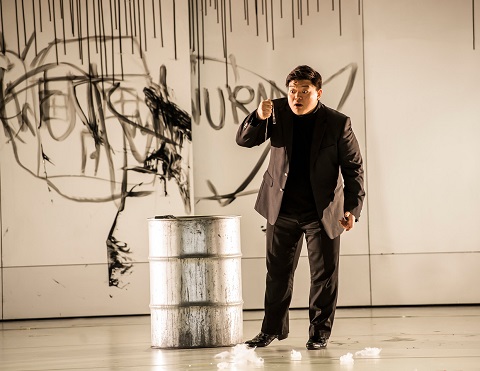 David Junghoon Kim. Photo credit: Tristram Kenton.
David Junghoon Kim. Photo credit: Tristram Kenton.
Horáková told the story with clarity, and with no additions and subtractions; she told the story with and through the music (her only alteration was that Wurm did not die at the end). Her chosen language was that of European regie-theater, a style which we do not see regularly in the UK. It is perhaps worth bearing in mind that Horáková's theatrical language would be familiar to many of the opera-goers in Wuppertal. It is also worth bearing in mind a comment by Bernard Haitink. He conducted the Richard Jones production of Wagner's Ring Cycle at Covent Garden; though Haitink famously had doubts about the production, he conducted it because Jones drew such superb performances from the singers and said that it was impossible to dissociate the production from the musical values. So, coming out of this production saying we enjoyed the singing but disliked the production style is doing Horáková a disservice.
Whilst I have no particular enthusiasm for this style of production, I have no objection to it either. As I have said, Horáková told the story with clarity and drew strong performances from her cast as she drilled down into the more complex psychological underpinning of the story. Though it is clear from the interview with her in the programme book that every detail meant something, the visual style of the production was rather too cluttered, what with clowns, balloons, two children representing the more innocent side of Luisa and Rodolfo, dancers who according to Horáková represented the Darkness which was personified by Wurm, the white walls on which people scrawled, the ubiquitous use of a tar-like substance which seemed to get everywhere.
But this emphasis on the psychological paid dividends in the performances which were outstanding, and for the first time I experienced Luisa Miller as riveting drama. It helped that for Acts Two and Three, Horáková allowed us to concentrate on the singers and these two had a far greater sense of focussed drama. We should also bear in mind the negative benefits of Horáková's style, the production lacked the trivialising prettiness of a traditional staging, she stuck to the story and didn't give us her version of Luisa Miller, and there was no over-sexualisation of the plot. Eva-Maria Van Acker's costumes, whilst being of mixed eras and styles (including the chorus in vaguely clown-like Day of the Dead style), gave us a clear distinction of the class layers in this work. Class is important in many 19th century operas, and too many opera directors tend to play this factor down. And those white walls, whilst writing on white walls is a bit of a tired trope I did love the way that black dribbled down them in the second half, giving us a visual metaphor for the way the Darkness encroached. Though the cleaning and laundry bill each night must be huge!
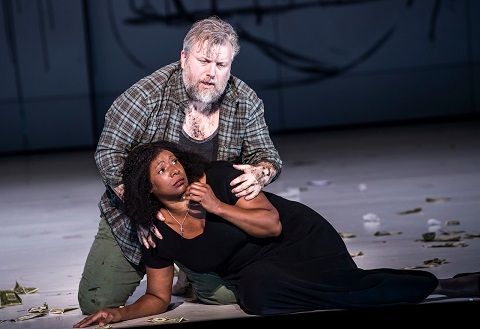 Olafur Sigurdarson, Elizabeth Llewellyn. Photo credit: Tristram Kenton.
Olafur Sigurdarson, Elizabeth Llewellyn. Photo credit: Tristram Kenton.
Technically there are three leading roles (Miller, Luisa, Rodolfo) and three smaller ones (Walter, Wurm, Federica), but the smaller ones received such strong performances here that we had little sense of this hierarchy, instead there was a superb ensemble feel supporting strong individual performances.
Elizabeth Llewellyn was outstanding as Luisa, a young woman who has to grow up quickly and face the real world. She had the flexibility to sing Luisa's often elaborate vocal writing whilst being able to draw out a strong, shapely vocal line. She also conveyed Luisa's psychological journey with great intensity, Llewellyn is a singer who is able to convey much with face and with eyes, this was an intense and gripping experience.
She was well partnered by David Junghoon Kim as Rodolfo. Kim was vivid and tireless in the role, and whilst he did not have the ideal open-throated Italianate sound, he sang with a wonderful intensity whilst giving us a gorgeous mezza-voce for his cavatina at the beginning of Act Three. We never really see Luisa and Rodolfo/Carlo in happier times, but their final long scene as the two lay dying was transcendently magical. The men in the opera are all various types of shit. Whilst Rodolfo happily dupes Luisa, he immediately jumps to conclusions when things go wrong for her.
Her father, by contrast is simply a selfish old git, he pretends to be concerned for her welfare, but he really wants her as a comfort for his old age. Olafur Sigurdarson managed to make the character human, if not entirely sympathetic, and in Act Three when released from prison both he and Llewellyn captured the sense of trauma that the characters have gone through. Sigurdarson's singing was admirably strong and focused, with a great feeling for Verdi's line though there were moments when I worried that he was trying a bit too hard.
Wurm is traditionally portrayed as ugly in some way so that his exterior matches his evil interior, but Soloman Howard's Wurm was anything but. Tall, handsome, physically fit (we got a good view of his upper body muscles) and sexy, Howard was completely mesmerising and disturbing. On stage for a good bit of the time, Howard's presence as Wurm radiated his sense of control and contributed considerably to the character's omnipresence in the plot. Howard sang with a fine, dark line making Wurm as vocally seductive as he was physically, this was an amoral character whom it would be difficult to resist.
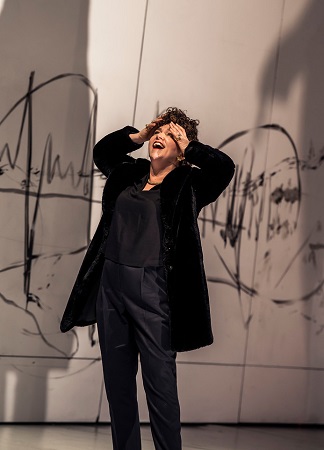 Christine Rice. Photo credit: Tristram Kenton.
Christine Rice. Photo credit: Tristram Kenton.
James Creswell had a different, but equally strong presence as Count Walter; Creswell was the embodiment of entitlement as well as a certain amorality, but also an underlying weakness which was his downfall. Christine Rice was a complete delight as Federica, and we wished Verdi had got his way and made more of the character. Nadine Benjamin, in fine voice, seized her moments as Luisa's friend Laura. Adam Sullivan (a member of the ENO Chorus) gave sterling support as a citizen (in the original, a peasant).
Perhaps more important than individual performances was the terrific feeling of interaction between these, so that the duets and ensembles fair crackled, the dialogue gripped and flowed particularly the scenes between Miller and Luisa, and Luisa and Rodolfo in the last act, creating some fine musical drama.
Andrew Lieberman's sets with their large flat surfaces provided valuable support to the singers, and the expanded ENO Chorus was in terrific form. This was one of the first operas in which Verdi actually made the chorus part of the action; here they are fellow villagers, and the chorus members really seized their opportunities and created a strong dramatic presence.
In the pit, Alexander Joel drew impressive playing from the orchestra, this was an impulsive and dramatic performance. Joel clearly knows and understands Verdi, and this was an account of the opera where the drama and the music were linked, so that moments like Verdi's important long recitative sections were finely fluid, whilst the big moments were thrilling.
By the end of this evening it was impossible not to be gripped by the drama, and to be fully engaged by the music. ENO had put together a strong cast, and Joel and Horáková drew from them some thrilling drama and very fine Verdi singing indeed.
Robert Hugill
Verdi: Luisa Miller
Count Walter - James Creswell, Rodolfo - David Junghoon Kim, Federica - Christine Rice. Wurm - Soloman Howard, Miller - Olafur Sigurdarson, Luisa - Elizabeth Llewellyn, Laura - Nadine Benjamin, A Citizen - Adam Sullivan, Dancers (Stephanie Bentley, Sam Ford, Anna Holmes, John William Watson), Children (William Barber/David Cummings, Halle Cassell/Taziva-Faye Katsande); Director - Barbora Horáková, Conductor - Alexander Joel, Set Designer - Andrew Lieberman, Costume Designer - Eva-Maria Van Acker, Lighting Designer - Michael Bauer, Choreographer - James Rosental, Orchestra and Chorus of English National Opera.
English National Opera, London Coliseum; Saturday 15th February 2020.
image=http://www.operatoday.com/Nadine%20Benjamin%2C%20Elizabeth%20Llewellyn%2C%20Soloman%20Howard%2C%20.jpg image_description= product=yes product_title=Luisa Miller, at English National Opera product_by=A review by Robert Hugill product_id=Above: Nadine Benjamin, Elizabeth Llewellyn and Soloman Howard.Photo credit: Tristram Kenton
Eugène Onéguine in Marseille
The original 1997 production born in Nancy (near Strasbourg) was revived in Nantes (the central Atlantic coast) in 2015 and seen in Saint-Étienne (near Lyon) in 2016, in Nice in 2017 and in Toulon (near Marseille) in 2019 before arriving finally just now in Marseille. All the editions have been staged by the original stage director Alain Garichot though with completely different casts, often Russian, and conductors.
The Opéra de Marseille hit the casting jackpot with a quartet of lesser known French singers (and one ringer — Nicolas Courjal as Gremin) and with young American conductor Robert Tuohy, now music director of the Opéra de Limoges (center southwest of France). The maestro was the ever present, matter of fact purveyor of Tchaikovsky rich panoply of expressive themes, his woodwinds dancing to intensify every movement of poetic beauty flowing through the words of Tchaikovsky’s self made libretto. Mo. Tuohy let Tchaikovsky’s opera be about the words of Pushkin’s troubled lovers, carefully parsing the orchestral phrasing to support these eloquent speakers. And sometimes letting loose with shattering fortes when only the orchestra had something to add.
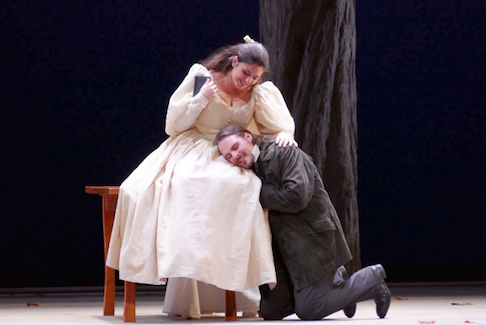 Emanuela Pascu as Olga, Thomas Bettinger as Lenski
Emanuela Pascu as Olga, Thomas Bettinger as Lenski
And speak they did, each of Pushkin’s characters pouring out their hearts in performances that were not about singers and singing, these were human beings who opened their hearts, intimately, laying bare their raw souls. We sat spellbound, rarely, and reluctantly interrupting the flow of emotion by applauding the famed arias.
Baritone Régis Mengus brought grace and elegance to Pushkin’s bored, existentially “superfluous” hero whose discovery of feeling and change of heart brought an extended, electrifying ending to the evening. In convincing voice he waltzed solo, with consummate skill to his confrontation with Lenski and then coldly shot his best friend in a precisely executed duel. Silently, eloquently he then remained on the stage, lost, during the a vista transformation to Gremin’s ball, months maybe years later.
Tenor Thomas Bettinger sang Lenski impeccably, whose Chopinesque coiffure gave him a poetic presence that made him the poet Pushkin, lest we forget that Pushkin himself was killed in a similar duel. With a spontaneous energy he greeted his intended bride Olga in the first act, then exploded in spontaneous anger in the second act before reflecting on his life, the famed “Kuda, kuda vy udalilis” from an almost detached, closely personal perspective. He then allowed Onegin to kill him — there was only one shot fired.
Soprano Marie-Adeline Henry sang Tatiana, lost within herself, participating quietly, distantly emotional in the wonderful first act quartet of the four women’s voices. She connected with herself in a full, if innocently voiced discovery of her infatuation with Onegin in the Act I Letter Scene. She was then silently, deeply shamed by Onegin’s rebuff. And finally she again connected with her deepest feelings in the final scene with Onegin, this time in a fully lyric dramatic voice, her chagrin turned into electrifyingly personal sacrifice.
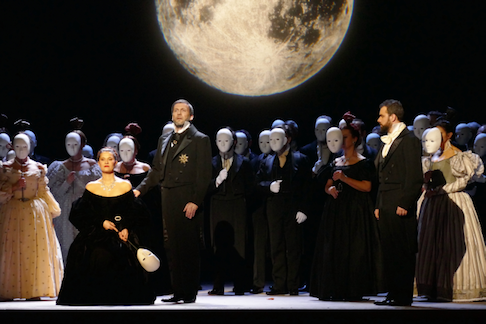 Marie-Adeline Henry as Tatiana, Nicolas Courjal as Gremin, Régis Mengus as Onegin
Marie-Adeline Henry as Tatiana, Nicolas Courjal as Gremin, Régis Mengus as Onegin
Bulgarian mezzo soprano Emanuela Pascu is making her career in France though she returns to Bucharest from time to time to sing what must be a beautifully voiced Carmen. Her brilliant first act aria moved effortlessly through the Carmen tessatura with a lightness of spirit that made her Olga a charming, capricious if uncomplicated young woman in love who when called upon could add a powerful, vocally dramatic presence to Tchaikovsky’s masterfully constructed first and second act ensembles.
Bass Nicolas Courjal sang Gremin. Mr. Courjal is a powerful presence (once a Phillip II on the Marseille stage) who made Gremin’s aria a song of his enraptured love for Tatiana, a profound, very alive love he had found later in life. This glowing presence of deep love became the emotional backdrop for the opera’s final scene, the shattering realizations of both Onegin and Tatiana that all love was forever lost.
Gifted with this cast of fine singers of appropriate ages, bodies and spirits stage director Alain Garichot can be credited with evincing these deeply personal, intimate performances of this conceptually unadorned production. Mr. Garichot’s directorial prowess comes out of his many years of formation at Paris’ Comédie Française (an esteemed group of classical actors founded by Moliere in 1680) to teach operatic acting at the young artist program at the Paris Opera and other European opera formation programs.
Mr. Garichot used little else than his singers to realize this emotionally pointed exposition of this operatic masterpiece. He needed no scenery nor did he have much. There were but nine soaring, foliage bare tree trunks on the stage that then disappeared into the loft for the Gremin ball. The only backdrop present was precise detail of character in the masterful enactments of Tatiana’s mother Lariana sung by Doris Lamprecht, Tatiana’s nurse sung by Cécile Galois, the Triquet sung Be Éric Huchet and Lenski’s second sung by Sévag Tachdijian. Of special notice throughout the first act, infusing inescapable actuality, was the mute presence of the nurse Filipievna’s grandson, the messenger of Tatiana’s love.
When it was all over no one dashed for the exits. We all remained seated for extended, solid applause, though there were some whistles (negative) and boos for select singers, and particularly for the conductor. Marseille lived up to its raucous reputation.
Michael Milenski
Production information:
Chorus and Orchestra of the Opéra de Marseille. Conductor: Robert Tuohy, Mise en scène: Alain Garichot; Choreographer: Cookie Chiapalone; Scenery: Elsa Pavanel; Costumes: Claude Massoni; Lighting: Marc Delamézière. Opéra Municipal, Marseille, France, February 13, 2020.
image=http://www.operatoday.com/Onegin_Marseille1.png
image_description=
product=yes
product_title=Eugene Onegin in Marseille
product_by=A review by Michael Milenski
product_id=Above: Marie-Adeline Henry as Tatiana, Régis Mengus as Onegin
All photos by Christian Dresse courtesy of the Opéra de Marseille
February 12, 2020
Opera Undone: Tosca and La bohème
I don’t think what Opera Undone chose to do with Puccini’s Tosca and La bohème would appeal in the slightest to purists, but on its own terms it was highly imaginative - and not particularly beyond the parameters of some staged productions we might see today at ENO, Salzburg or even Bayreuth.
Where Opera Undone differs is in the concentration of the libretto to an hour in length for each opera, a translation into vernacular English which bears almost no resemblance to the Italian original and in themes which evoke periods in time which are centuries beyond Puccini’s settings. The staging of each opera is so minimalist we could really be anywhere rather than somewhere in particular - it’s almost the Theatre of the Absurd; Ionescu and Beckett, or even Genet, colliding with Puccini. Tosca is probably the less controversial of the two productions here; La bohème is absolutely controversial - and, it should be said, one of the funniest, yet undoubtedly tragic, performances of an opera I have seen.
La bohème , according to Opera Undone, is about polyamory, homosexuality, cruising for picks-ups on gay chatlines, sexual identity, HIV, drug addiction and co-dependency. In one sense I was interested in seeing this production because it was set in Peckham, a part of south London a few miles from the very leafy part of the city in which I live. It would have been easy to stereotype, and, in a sense, this is rather what happened. Marcello (here called Marcus) is every inch the typical Peckham, white, working-class guy - right down to the leather jacket, and silver chains around his neck and wrists. Musetta (Melissa) was even worse. Only Rodolfo (Rod) and Mimi (Lucas) stand outside the stereotypes (though I do know a lot of gay men who wear plaid shirts and jeans). But the subjects touched on are universal, they could have, and do, infect every part of a city. Tosca was simply set in New York; Puccini’s original simply Paris.
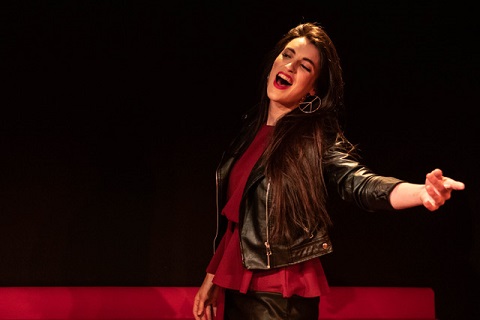 La bohème. Photo credit: Ali Wright.
La bohème. Photo credit: Ali Wright.
Condensing either opera down to an hour certainly isn’t easy. Tosca was better done, and we got a fairly good slice of the Scarpia - Tosca scene from Act II here. The focus on both operas was to maintain the big arias - so we got ‘Recondita armonia’, ‘Vissi d’arte’ and ‘E lucevan le stelle’ (or versions thereof), and the same was the case in La bohème. Mimi’s lingering death - whether it be from tuberculosis or from a drug overdose - or whether it is wrought with the power of emotion or with a foaming mouth is long in whichever version one sees it. It is no longer a challenge for an audience to see two men kiss on stage, nor for a libretto to be liberally peppered with “fucks” here and there.
The humour in both productions could perhaps have seemed misplaced, but it worked very well. Cavaradossi (abbreviated to Cav) is still an artist, though should one feel pity for the woman in the audience who spent much of Act I with a picture frame hanging from her shoulders? La bohème was even more striking for involving the audience. Musetta spent an awfully large part of Act I sitting between people or draping herself over them. But strip the humour out and there were moments of drama. Cavaradossi received quite a beating before being hooded and shot; Mimi’s drug induced death was raw, and certainly done with a sense of reflective realism.
The singing was largely very impressive, though the rather intimate size of Studio 2 at Trafalgar Studios can magnify, and sometimes strain, the tone of the voices to a considerable degree. I think all of the soloists deserve credit for bringing in performances that were very well sung - balancing pathos and humour with equitability, and acting, that never bordered on the wooden. Fiona Finsbury’s Tosca was a standout performance, extremely nuanced, and really quite powerful throughout Act II. The notes are there, her upper range entirely confident. She had no difficulty suggesting Tosca’s growing revulsion or despair. The other dominant performance was the Rodolfo of Roberto Barbaro. I think he started slightly short on confidence, but the warmth and colour of his voice is beautiful to listen to. One is entirely persuaded that this is a tenor who emotes what he sings; I could swear that in his duet with Mimi, where Mimi confesses to his drug use after their relationship has ended, there were genuine tears in his eyes.
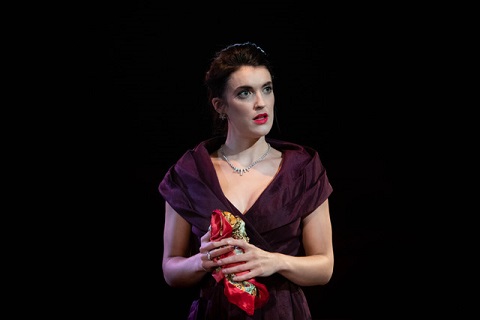 Tosca. Photo credit: Ali Wright.
Tosca. Photo credit: Ali Wright.
Honey Rouhani’s Musetta was high on humour and high on vocal strength. Roger Paterson’s Cavaradossi provided a couple of moments during his ‘E lucevan le stelle’ where his top notes had both more security at the top and stability in the length of them than I have heard more star name tenors sing. Hugo Herman Wilson’s Scarpia was never short on power, and neither did he shirk from imbuing this particular 1940’s mafia version of him with all his Scarface terror. Michael Georgiou’s Marcelo - he who had voted Tory just once - bounced between Rodolfo and Musetta with witty confidence. Philip Lee’s Mimi ended up becoming a heartrending performance that leant inwards to its inevitable tragedy - the voice clearly capable of going to extremes. His ‘Si, mi chiamano Mimi’ had brought out a very funny side to him as he described selling perfume and taking the late shift at Liberty; and yet, he was entirely moving as he brought an almost positive happiness to his terminal sleepiness after taking one last hit of drugs.
Entirely outstanding throughout the entire evening was David Eaton’s playing of the formidably taxing piano parts of Puccini’s scores.
I’m not sure what my expectations were for this particular evening. Whatever they might have been, purism wasn’t one them. This was in many ways operatic revisionism, opera as theatre, opera as popular art, opera as openly accessible. It could be serious and humorous in equal measure and was an entirely enjoyable way to spend two hours.
Marc Bridle
Opera Undone: David Eaton (Music Director), Adam Spreadbury-Maher (Director)
Tosca : Tosca - Fiona Finsbury, Scarpia - Hugo Herman Wilson, Cavaradossi - Roger Paterson
La bohème : Rodolfo - Roberto Barbaro, Mimì - Philip Lee, Musetta (Melissa) - Honey Rouhani, Marcelo (Marcus) - Michael Georgiou
Trafalgar Studios, London; Tuesday 11th February 2020.
image=http://www.operatoday.com/La%20bohe%CC%80me%20%28c%29%20Ali%20Wright.jpg image_description= product=yes product_title=Opera Undone at Trafalgar Studios product_by=A review by Marc Bridle product_id=Above: La bohèmePhoto credit: Ali Wright
A refined Acis and Galatea at Cadogan Hall
It was at this estate near Edgware, north-west of London, that the year before Handel had gained employment among the group of musicians that Brydges maintained to perform in his chapel and at private entertainments.
To celebrate their 40th anniversary in 2019, Harry Christophers and The Sixteen released a recording of Acis and Galatea , performed - in accord with what are thought to be the circumstances of the work’s premiere - by an intimate ensemble of just five singers and nine instrumentalists. A year later, The Sixteen have embarked upon a mini-tour of the work, beginning here at Cadogan Hall with further concert performances to follow in Chichester, Derby and Warwick .
The Sixteen’s 2019 disc won the Preis Der Deutschen Schallplattenkritik Best Listen Award; and, at Cadogan Hall, one could understand why. Handel’s beautiful melodies flowed one after the other, sung with mellifluence, elegance and good taste by the five vocal soloists. The nine instrumentalists from the Orchestra of the Sixteen played with similar graciousness of style. The continuo ensemble - cellist Joseph Crouch, theorbo player David Miller, harpist Frances Kelly and harpsichordist Alastair Ross - provided sensitively detailed support. The many instrumental obbligatos conversed engagingly with the voices, Catherine Latham’s sweet piping unheeding of Galatea’s plea to “Hush, ye pretty warbling quire!”; Hannah McLaughlin’s oboe warmly conveying the heat of passion within the eager Acis’ breast; Kelly’s harp embodying the glow of Galatea’s love when reunited with her smitten shepherd.
Arranged symmetrically - the violinists (leader Sarah Sexton and Daniel Edgar) standing stage-right, balanced by the continuo group stage-left - with Christophers dancing lightly on his toes at their centre, the musicians formed a ear-pleasing consort in front of the seated singers at the rear of the stage. So, what could there be not to like?
Well, while the musical performances could not be faulted, I missed the wit, drama and emotion which is present in both John Gay’s libretto and Handel’s score. In Grove, Stanley Sadie speculates: ‘Whether or not it was originally fully staged, given in some kind of stylized semi-dramatic form or simply performed as a concert work is uncertain; local tradition holds that it was given in the open air on the terraces overlooking the garden (the recent discovery of piping to supply an old fountain, suitable for the closing scene, might fancifully be invoked as support).’ And, when Acis and Galatea was presented in a revised three-act version (incorporating musical material from Handel’s cantata Aci, Galatea e Polifemo (Naples, 1708) with words by Nicola Giuvo) at the King’s Theatre in June 1732, the advertisement read, ‘There will be no Action on the Stage, but the Scene will represent, in a Picturesque Manner, a rural Prospect, with Rocks, Groves, Fountains and Grotto’s; amongst which will be disposed a Chorus of Nymphs and Shepherds, Habits, and every other Decoration suited to the Subject’.
At Cadogan Hall, we had neither a ‘rural Prospect’ of Arcadian serenity nor any ‘Action’. The singers undertook, in turn, a decorous progress to the front of the stage to sing their arias, then retreated to resume their positions in the Chorus. It was all very polite and tasteful: ‘courtly’, said one of my colleagues. But, there was little sense of the emotions or psychologies that the work expresses and explores. When Acis and Galatea stood side by side to celebrate their reunion with the joyous, bubbling cries of “Happy we!”, they scarce looked at each other, their apparent indifference surely at odds with their blissful avowals, “Thou all my bliss, thou all my joy!” Similarly, though Polyphemus stood nearby, the audience not the ogre was the recipient of Galatea’s command, “Go, monster, bid some other guest/ I loathe the host, I loathe the feast”? And, because the monstrous one did indeed beat a retreat, Coridon’s implorations to his master to “Softly, gently, kindly treat her” were sung to no-one in particular.
But, if there was dramatic restraint, there was also musical refinement. In ensemble, the five voices blended well - just occasionally one of the tenor lines rose overly to the fore - and the collective voices captured the expressive contrasts between the pastoral peace at the start, singing with relaxed expansiveness, “O, the pleasure of the plains!”, and the foreboding atmosphere at the start of Act 2: “Wretched lovers!” The singers moved as a group to the front, in order to plead for all the “muses” and “swains” to grieve Acis’ demise, and though there was no prone figure of the slain Acis over which to mourn, they captured both the tenderness and gravity: “the gentle Acis is no more!”
The virginal purity of Grace Davidson’s soprano made this Galatea a truly other-worldly sea nymph. There was perhaps a limited range of colour, such as would imbue Galatea’s excited image of the dove, “Billing, cooing/ Panting, wooing”, with requisite passion; but Davidson’s exquisite sense of line and her tasteful, gentle ornamentation - a graceful appoggiatura or two, an occasional trill to ruffle the nymph’s serenity - were more than recompense.
Acis is a rather dull dude, and Jeremy Budd seemed a little reserved initially. I didn’t sense Acis’ naïve impetuousness in “Where shall I seek the charming fair?”, and the repetitions of the “Love” which “in her eyes sits playing” and “on her lips is straying” might have been more pointed - the mood was jaunty rather than sensuous. But the tenor’s tone was beautifully lucid and softly sweet. As Damon, tenor Mark Dobell conveyed a stronger sense of presence, and the sensible swain’s Act 2 aria, “Consider, fond shepherd”, was persuasively earnest.
Polyphemus shatters the lovers’ Elysian idyll and it was when bass Stuart Young took to the forestage that there was an injection of the sort of dramatic impetus and characterisation that had thus far been lacking. Singing from memory, Young really did “rage - melt - burn” and in “O ruddier than the cherry” he upset the pastoral serenity, singing with strong tone, excellent diction and well-judged rhythmic freedom to suggest the “raging flame” of desire within his heart. Young captured both the ridiculousness of Polyphemus’ hyperbolic passion - Latham’s sopranino recorder adding its ironic commentary - and, in a beautifully coloured “Cease to beauty to be suing”, the monster’s frustration and pathos.
Gay’s libretto balances the ‘high’ with the ‘low’; and in Handel’s music there is wit and irony, as well as deep emotion. If both the levity and the intensity were a little lacking on this occasion, then there was musical earnestness and expressive beauty. A good listen, indeed.
Claire Seymour
Handel: Acis and Galatea
Galatea - Grace Davidson, Acis - Jeremy Budd, Damon - Mark Dobell, Coridon - Simon Berridge, Polyphemus - Stuart Young, Conductor - Harry Christophers, members of the Orchestra of The Sixteen.
Cadogan Hall, London; Tuesday 11th February 2020.
image=http://www.operatoday.com/The%20Sixteen.jpg image_description= product=yes product_title=Acis and Galatea: The Sixteen, conducted by Harry Christophers, at Cadogan Hall product_by=A review by Claire Seymour product_id=Above: The SixteenFebruary 11, 2020
Lise Davidsen: A superlative journey through the art of song
I have sometimes thought the Barbican Hall is an unforgiving place for a
song recital - it certainly proved so for Diana Damrau when I heard her
here last year. This was absolutely not the case for the Lise Davidsen.
Launching straight into Brahms’s ‘Auf dem Kirchhofe’ the enormity and
grandeur of the voice almost knocks you over. If the sombre setting of this
song might seem a slightly odd place to begin a recital, it’s the template
of the music itself which demonstrates all that is so compelling about her
vocal command. The switch in register, the seamless joins between the notes
as if they are woven from the same cloth, the faultless way in which the
accents are shaped are all absolutely beautiful to hear. The way in which
she could just descend into a pianissimo had all the effect of
suspension in gravity.
Many of Brahms’s songs owe a huge debt to Schubert and their very Germanic
nature, along with the composer’s typical compositional style, don’t make
them suitable for every kind of soprano. They do for Davidsen. ‘Liebestrau’
makes full use of a singer’s dramatic range. The song might be simple in
genesis, but musically it is miniature opera, set magically in dialogue
with the bass register of the piano to mirror the conversation between a
mother and daughter. The depth of her tone here was sumptuous - and yet it
remained entirely feminine. ‘Von ewiger Lieber’ struggles between two
worlds of darkness and light; the effect of James Baillieu’s often
blackened embers on the piano emerged through the shadows into Davidsen’s
ravishing, flaming embers of hope.
Schumann’s ‘Gedichte der Königin Maria Stuart’ - five songs which form a
biographical history of the Scottish queen’s life from the birth of her son
through to her final prayer before her execution - can almost seem like an
autobiographical moment in the life of Schumann, especially in his final
years. There is little that is romantic about this music; though, they are
Romantic in a very mid-nineteenth century context. Mary Stuart’s fate seems
closely intertwined with Schumann’s aborted drowning, and his admission to
an asylum - but it’s the astringency, rawboned and sparse contours of the
songs which demand most from the soprano singing them, all of which this
singer can evoke from her voice. Davidsen avoided lyrism almost entirely,
even in the second song “Nach der Geburt ihres Sohnes” which reflects on
the birth of Mary Stuart’s son. Again and again, she touched on the
feminine in her voice, even though the striking sparseness in her tone
could easily have pushed her into somewhat less delicate territory. Nothing
quite prepared us for the simply shattering power Davidsen and Baillieu
brought to the prayer and her execution, “Abschied von der Welt”. It simply
chilled me to the bone. The voice here was less dark, simply bleak, and yet
the devastation was palpable. This was an execution that reminded me of the
terror that Berlioz gave us in his ‘Marche au supplice’ from his Symphonie fantastique.
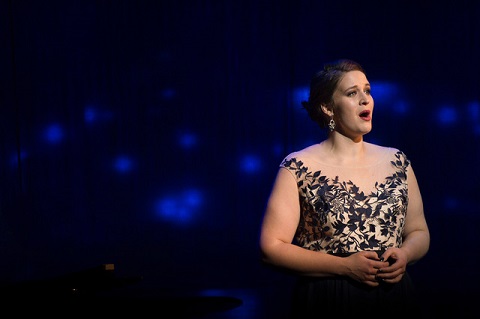 Lise Davidsen. Photo credit: Ole-Jørgen-Bratland-Statoil.
Lise Davidsen. Photo credit: Ole-Jørgen-Bratland-Statoil.
The first half ended with Sibelius’s ‘Luonnotar’. The work was originally
written for soloist and orchestra (and premiered in Gloucester in 1913) but
Sibelius subsequently reworked it for piano and soprano. Its challenges are
formidable - in its length, its intensity and its vocal demands, and
perhaps even its language. The performance which Lise Davidsen gave was as
definitive as any I’ve ever heard, closer to Söderström in its ravishing
storytelling than lighter sopranos who have attempted it. But, the range of
the voice was also exceptional - everything minutely in place, from the low
chest register right up to those vertiginous octaves. Her ability to
sustain drops in notes, often between attached words, was simply
breath-taking.
The Sibelius songs which followed were less virtuosic, though in a piece
like ‘Little Lasse’ it was the essence of lullaby which Davidsen charmed us
with. The calibre of this romantic voice, with its sunlit and glowing
warmth, was ample enough in ‘The first kiss’, just as in ‘Was it a dream’
she spun a lustrous wave of melody that swept like a first romance against
James Baillieu’s lushly poised piano. The three Grieg songs, whilst drawing
on German Romanticism, can altogether seem more despairing - songs of
denied passion, death becoming, the charting out of anguish and dissolving
intimacies are but short - although dense - poems, but Davidsen brought to
them a bewildering range of detail and emotional depth.
The rest of the recital was devoted to Richard Strauss, the composer who
had caused me to wonder what I was missing in Lise Davidsen’s voice. In
this recital - if not on disc - she was simply stunning. Opening her
Strauss songs with one of Strauss’s greatest, and most taxing, ‘Zueignung’,
I was slightly reminded of the maxim that pianists are best advised to
avoid opening a piano recital with Mozart. It didn’t matter here. The
architecture Davidsen is able to bring to Strauss songs is very notable -
she builds crescendos with superb convexity, the arc of many of them almost
curving from the pages of the scores like a crescent shaped moon in its
perfect symmetry. There is absolutely no breaking of the line, no pause in
the breath between words - every note is amply supported. It’s very rare,
in fact non-existent, to hear this singer clutch at words. Strauss does not
avoid drama or theatre in ‘Zueignung’ and neither does Davidsen - and her
final “Habe Dank” was one of the best shaped, rising from nowhere, and most
thrillingly held, I have heard for absolute years.
‘Allerseelen’ is quite a contrast, though a song with rather multiple
interpretations. I think Lise Davidsen rather saw it more as a
commemoration of love rather than an attempt to revive a lost one - there
were touches of mystery in the voice, less pointed references to the past.
‘Die Georgine’ - The Dahlia - a song less heard in Strauss recitals has
considerable beauty to it, blazes of colour in both the voice and piano
that are fragrant of the flower’s florets and striking blossom. Here, she
brought a humanity to her voice as the music reflects on pain and joy of
love. ‘Wiegenlied’, which had been slightly distant and inclined towards
being rather straight, in my view, on her disc with Salonen, was here quite
the opposite. There was a luxuriousness to the tone, a warmth which suited
the darkness of her voice - those majestic tones, the hues of colour which
seem rather unique to her. Taken at a beautifully slow pace, the lines
opened up with impeccable ease, the control in the breath almost completely
singular from bar to bar. ‘Malvern’ is rather close to the Vier letze Lieder in style and meaning, its intimacy just as
challenging. The piano’s solo interlude, its soaring lines, but demand for
the singer to perhaps hold back a little, brought much out of Davidsen.
‘Cäcilie’ brought us full circle to the taxing opening of Strauss songs,
the voice as rich as Christa Ludwig’s used to bring to this music.
Everything about Davidsen’s performance of it leaned towards its rapturous
lines, but there was no lack of unconstrained ecstasy or radiance behind
the words either. The crescendo was simply flawless, rising like an eagle
in flight, the breath control configured to seem almost infinite. In every
way, James Baillieu was an impeccable partner.
Rather unusually, and perhaps not causing any distraction, much of this
recital was accompanied by varying degrees of light. Small boxes scattered
around the stage seemed to add intimacy, and in other songs the wooden
organ pipes were bathed in blues, reds and greens. At times, her dress was
simply the single focus of light twisting in spirals on its bodice. This
all added to a recital which was a journey through the art of song; but it
was also a recital which was an artistic triumph and, I think, one which
will be remembered for quite some years.
Marc Bridle
Lise Davidsen (soprano), James Baillieu (piano)
Brahms: ‘Auf dem Kirchhofe’, ‘Da Unten im Tale’, ‘Mädchenlied’ from 5 Songs Op.107 No.5, ‘Liebestreu’ from 6 Songs Op.3 No.1, ‘Von ewiger Liebe’ from 4 Songs Op.43 No.1; Schumann: Gedichte der Königin Maria Stuart; Sibelius: Luonnotar Five Songs Op.37; Grieg ‘Dereinst Gedanke Mein’, ‘Zür Rosenzeit’, ‘Ein Traum’; R. Strauss: ‘Zueignung’, ‘Allerseelen’, ‘Die Georgine’, 'Wiegenlied', ‘Malven’, ‘Befreit’, 'Caecilie'.
Barbican Hall, London; Monday 10th February 2020.
image=http://www.operatoday.com/Lise-Davidsen-Photo-Ole-J%C3%B8rgen-Bratland-Statoil.jpg image_description= product=yes product_title=Lise Davidsen at the Barbican Hall product_by=A review by Marc Bridle product_id=Above: Lise DavidsenPhoto credit: Ole Jørgen Bratland
February 7, 2020
Parsifal in Toulouse
The Orchestra National du Capitole earned its international reputation in the late 20th century with its conductor Michel Plasson and has retained its stature as one of France’s finest symphonic ensembles into the 21st century. Its quality was well evidenced at the fifth (and final), highly polished performance of Parsifal. Orchestrally there was an unfaltering beauty of tone throughout Parsifal’s wide dynamic register and its evolving intensities, and a suppleness of ensemble that softly and quite precisely sculpted Wagner’s unending flow of motives.
Conducting was Frank Beermann, long associated with an ongoing (since 2002) Wagner project at the Stadttheater Minden (near Hanover). Like many conductors Mo. Beermann takes much slower tempos than those prescribed by Wagner himself, resulting in a quite long evening. Nonetheless it efficiently spread the mysteries of Wagner’s rite of redemption into a musical and dramatic structure that entranced the audience for those many hours. Maestro Beermann and the orchestra were awarded a huge ovation when it was all over.
Toulouse assembled a remarkable cast led by Austrian tenor Nikolai Schukoff as Parsifal. Lithe and handsome Mr. Schukoff is not Wagner’s fool. He is a male force (a hunter and a lover) that Wagner will redeem with the help of opera’s most complex, enigmatic heroine Kundry. French mezzo-soprano Sophie Koch was the Kundry in her role debut. She reads as a beautiful, sexual woman. She also projects an intelligence befitting a woman who feels and demands to understand the conflict and contradiction of body and soul that consume her.
Kundry’s second act seduction of Parsifal and Parsifal’s resistance was the epicenter of director Aurélien Bory’s staging of Wagner’s quest of salvation. Kundry was its key, Mme. Koch exploding vocally and emotionally. The stage was blank except for a narrow, dark wall against a pale glow. Kundry in a dark green gown stood in the glow on one side, Parsifal, in white, on the other as they began their epic encounter concert style. Eventually it became a physical brawl, the two bodies and minds in physical and intellectual battle. [see lead photo]
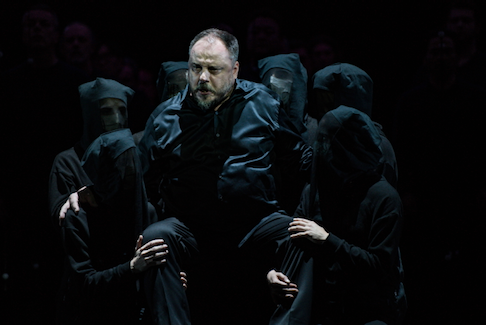 Matthias Goerne as Amfortas
Matthias Goerne as Amfortas
German bass-baritone Matthias Goerne was Amfortas. The wounded king was laid out in a horizontal chair carried by ninja-like bearers. Dressed completely in black he was tipped up to deliver his three excoriating monologues. Mr. Goerne, a lieder singer by choice, plumbed the depths of philosophical suffering with a profound musical intelligence in the voice of an operatically heroic bass, awesomely rising to his feet in his most intense moments.
Director Bory and his designer Pierre Dequivre worked with few scenic elements, each there for specific choreographic purpose — they were kinetic. The lance was a tube of light that sometimes lighted the face of someone in its wake. The tube was sometimes duplicated into many tubes of light that moved choreographically. The swan was a shadow puppet magnified onto a suspended slightly circular drape that then served as a gigantic reflecting surface for the immense Act I shadow revelation of the chalice.
A huge metal grid lay on the stage in Act I through which Gurnemanz appeared with his companions, the grid disappearing into the loft for the procession to the grail, Gurnemanz was sung by British bass Peter Rose in Falstaffian fashion though he attained true philosophic stature in his third act baptism of Parsifal.
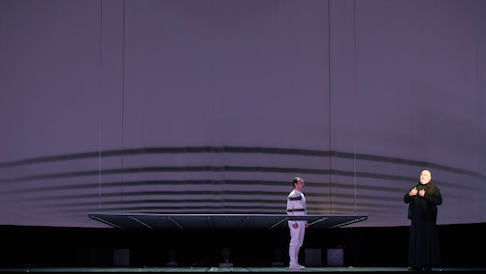 Act I, Gurnemanz leads Parsifal to the grail
Act I, Gurnemanz leads Parsifal to the grail
Circus-like the opera’s protagonists interfaced with the physical apparatus on the stage, the third act a huge cube of individual lights suspended in a black void. The lights illuminated in various configurations and intensities among, behind and over the protagonists to attain maximum illumination at musical and philosophical climaxes. Finally Parsifal, having shed his black knight attire, achieved his apotheosis, his salvation standing upon a cube, again in the white suit of his Act I entrance, now bathed in intense white light. The orchestral ascension that closes the opera found the male chorus on the stage in regimented formation echoing the geometric perfection of the cube of illuminated lights.
Director Bory has a huge presence in Toulouse, and this Toulouse Parsifal may well amplify that presence into a much, much larger, international sphere. Making Wagner’s enigmatic opera make perfect sense in a flow of light and dark encounters, really nothing more, was a monumental achievement.
Mr. Bory was assisted by Toulouse choreographer and Flamenco dancer Stéphanie Fuster with whom he frequently collaborates in dance pieces. Of great effect was the highly choreographed staging of the Flower Maidens, the six veiled singers lined across the stage, the choreography nothing more than the lifting and falling of their veils.
Michael Milenski
Cast and production information:
Nikolai Schukoff: Parsifal; Sophie Koch: Kundry; Peter Rose: Gurnemanz; Matthias Goerne: Amfortas; Pierre-Yves Pruvot: Klingsor; Julien Véronèse: Titurel; Andreea Soare, Marion Tassou, Adèle Charvet, Elena Poesina, Céline Laborie, Juliette Mars: Flower Maidens. Kristofer Lundin, Yuri Kissin, Enguerrand de Hys, François Almuzara: Knights and Squires. Chorus and Childrens Chorus of the Téâtre du Capitole augmented by the Chorus of the Opera de Montpellier. Orchestre National du Capitole. Frank Beermann: Conductor; Aurélien Bory: Mise en scène; Aurélien Bory and Pierre Dequivre: Scénographie; Manuela Agnesini: Costumes; Arno Veyrat: Lumières. Théâtre du Capitole, Toulouse, France, February 4, 2020.
image=http://www.operatoday.com/Parsifal_Toulouse1.png
image_description=
product=yes
product_title=Parsifal at the Théâtre du Capitole Toulouse
product_by=A review by Michael Milenski
product_id=Above: Sophie Koch as Kundry, Nikolai Schukoff as Parsifal
All photos by Cosimo Mirco Magliocca, courtesy of the Opéra de Marseille.
February 4, 2020
An Evening with Rosina Storchio: Ermonela Jaho at Wigmore Hall
Certainly, Jaho’s intense commitment and emotional empathy with the characters whom she embodies on stage inspire deep responses among audiences. When I mentioned to a friend that I was looking forward to hearing Jaho in the recital room, she commented, “I love her! I’ve never heard as much crying in the ROH as when we saw her Suor Angelica. Grown men were sobbing!”
Jaho’s debut recital was a celebration of 50 years of Opera Rara’s ground-breaking opera-archaeology and of the career of Rosina Storchio, the Italian soprano (1872-1945) who might be deemed the principal creator of much of the verismo repertoire that Opera Rara have revived, performed and recorded during the past five decades. Storchio came to notice in Venice in 1897 when she took part in the first performance of Leoncavallo’s La bohème - ‘Musette svaria sulla bocca viva’ from this opera was Jaho’s somewhat tentative opening item here - and the stellar years of her career began when Storchio sang the title role in the première of the same composer’s Zazà (at Milan’s Teatro Lirico on 10th November 1900, conducted by Arturo Toscanini - a role taken by Jaho herself in Opera Rara’s 2015 performance at the Barbican Hall.
Verismo might have begun as a French literary movement characterised by naturalism of expression and realism of subject matter, but in opera the term came to be seen as a shorthand for dramatic excess and sometimes violent vocalism. But, it didn’t have to be that way. Storchio herself had a voice that might be described as lirico-leggero. Grove describes her soprano as ‘not large, but flexible, pure and sweet’: ‘at the height of the popularity for verismo opera she personified the lyrical, refined, gentle school of singing. Her plaintive and fragile Cio-Cio-San was typical of this approach … [b]ut in other roles, such as Violetta or Manon, her acute sensitivity led her to depict the characters with passionate and touching impulsiveness.’
Such words might also describe Jaho herself, and in this programme - a mixture of excerpts from Storchio’s operatic repertoire and salon pieces and songs from the period, curated by Roger Parker, Opera Rara’s Artistic Dramaturg, and music historian Ditlev Rindom - she exploited the lightness and gentleness of her voice to the full, in particular her ability to make the longest phrases float tenderly, as if eternal, and then fade delicately with supreme control to the merest, tantalising whisper.
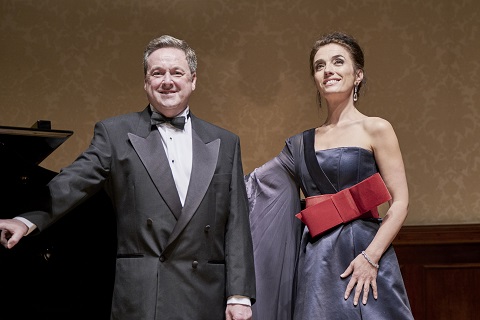 Steven Maughan and Ermonela Jaho. Photo credit: Russell Duncan.
Steven Maughan and Ermonela Jaho. Photo credit: Russell Duncan.
Jaho was at her best in the extracts from opera scenes depicting characters pushed to emotional extremes. If her diction was less than attentive to the careful naturalism of the composers’ word-setting, then she more than made up for this with powerful outbursts of lyric emotion which communicated with compelling honesty and directness. ‘Mamma? Io non l’ho avuta mai’ perfectly captured Zazà’s somewhat languid nonchalance at the start, before gradually gaining in intensity and colour. In contrast, ‘Un dì ero piccina’ from Mascagni’s Iris alternated anxious, breathless stutterings, gently nudged along by the piano’s steady rhythms, with expansive lyric moments, as when the young Iris recalls the shocking blood-red sky on a picture-screen she had seen as a child, depicting a woman being tormented by enormous octopus, a symbol of sexual violence. Jaho’s soprano was a surging burst of colour, “Rossi sì come sangue,/ D’un rosso livido.”, and at the close she stood immobilised by horror, her slender arms clasped across chest, her hands tightly clenched.
Steven Maughan, a member of the Opera Rara ‘family’, was a sensitive and supportive accompanist throughout the evening, but at such moments one felt the absence of an orchestral palette to complement the vocal hues with which Jaho so precisely delineated love and pain, fear and joy. The piano rumbled threateningly at the close of ‘Pendant un an je fus ta femme’ from Massenet’s Sapho, but even the Wigmore Hall’s Steinway was no match for the emotional intensity of Jaho’s impassioned vocal implorations, “Viens! Viens! Viens! M’ami!”, as Fanny calls upon the lover who has abandoned her to return and witness her suffering.
‘Son pochi fiori’ from Mascagni’s L’amico Fritz was infused with a gentle warmth, and sweetness billowed through ‘Nel suo amore’ from Giordano’s Siberia, in which Storchio took the role of Stephana at the premiere in Milan on 19th December 1903. The relaxed declamation of the opening, tenderly supported by the piano, evolved into sunlit images of love - heavenly light the aroma of spring flowers, and the diminishment of the soft repetition, “amor, amor!”, at the close was breath-taking.
Jaho seemed less comfortable in the salon pieces and songs. These comprised much of the first half of the recital, and perhaps it was a combination of nerves and excitement - arriving on stage, Jaho looked out at the capacity audience with a smile, a sigh and a slight shrug of the shoulders - but the soprano seemed to take a little while to settle in the items which lacked a distinct dramatic context. There were some slips of intonation, too, which marred Bellini’s ‘Vaga luna, che inargenti’ and ‘Malinconia, ninfa gentile’ and while the warmth of Jaho’s lower register added poignancy to Donizetti’s ‘Venne sull’ali ai zeffiri’ - a lament upon the death of Bellini - the rather wide vibrato employed did not seem entirely appropriate for Wigmore Hall’s intimacy and fine acoustic.
But, it was good to hear some unfamiliar repertoire. Jaho’s vocal characterisation in Cilea’s ‘Non ti voglio amar’ was affectionate and engaging, and the impassioned close to Tosti’s ‘Tristezza’ was compelling, as the voice floated up an octave all the while fading, and Jaho swooned onto the piano as if weakened by the knowledge that the heart’s dreams will inevitably be lost. And, we even had a song by Toscanini, ‘Nevrosi’, which throbbed with expansive emotions.
Jaho rose to the heights in the very final item, ‘Flammen perdonami’ from Mascagni’s Lodeletta, a role created by Storchio at the Teatro Costanzi in Rome on 30th April 1917 with the composer himself conducting. The libretto is characteristically excessive and improbable, and the opera has disappeared from the repertory. But, Mascagni knew how to exploit the voice for emotive and dramatic effect. In this 13-minute death scene, the 16-year-old Lodoletta, who has been abandoned by her lover, the Parisian painter Flammen (who comforted her upon the death of her adoptive father), arrives outside Flammen’s house on a freezing cold New Year’s Eve. Seeing him dancing with another woman, she mistakenly believes that he has forgotten her and collapses in the snow. Overcome by delusions that Flammens is embracing her, she succumbs to frostbite and freezes to death. Jaho exploited every drop of Mascagni’s hyper-Romantic emotionalism. The Wigmore Hall audience loved it.
Storchio had been the first Cio-Cio-San, creating the role at La Scala in 1904, and it was the final role that she sang on stage, in Barcelona in 1923. So, ‘Un bel dì’ was a fitting encore - the perfect conclusion to a fine evening.
Ermonela Jaho’s recital disc, Homage to Rosina Storchio , on which she is accompanied by the Orquestra de la Comunitat Valenciana conducted by Andrea Battistoni, will be released by Opera Rara in September 2020.
Claire Seymour
Ermonela Jaho (soprano), Steven Maughan (piano)
Leoncavallo - ‘Musette svaria sulla bocca viva’ (La bohème); Bellini - ‘Vaga luna, che inargenti’, ‘ Malinconia, ninfa gentile’; Donizetti - ‘Venne sull’ale ai zeffiri’; Verdi - ‘In solitaria stanza’, ‘Brindisi’; Leoncavallo - ‘Valse coquette’, ‘Mamma? Io non l’ho avuta mai’ (Zazà); Cilea - Non ti voglio amar; Tosti - ‘Tristezza’; Toscanini - ‘Nevrosi’; Mascagni - ‘Un dì ero piccina’ (Iris); Mascagni - ‘Son pochi fiori’ (L’amico Fritz); Gounod - Sérénade: ‘Chantez, riez, dormez’; Bizet - ‘Chanson d’avril’; Massenet - ‘Pendant un an je fus ta femme’ (Sapho), ‘Allons! Il le faut ... Adieu’ (Manon ); Giordano - ‘Valzer serenata’, ‘Nel suo amore rianimata’ ( Siberia); Puccini - ‘Sole e amore’; Mascagni - ‘Flammen perdonami’ (Lodoletta).
Wigmore Hall, London; Sunday 2nd February 2020.
image=http://www.operatoday.com/Ermonela%20Jaho%20WH.jpg image_description= product=yes product_title=An Evening with Rosina Storchio: Ermonela Jaho at Wigmore Hall product_by=A review by Claire Seymour product_id=Above: Ermonela JahoPhoto credit: Russell Duncan
February 3, 2020
Schumann Symphonies, influenced by song
This recording, from performances at the Barbican Hall, London, captures the verve and spontaneity of live performance, further enhancing the vividness of expression. This CD features Schumann’s Symphony no 1 in B flat major,Op. 38, (1841) and his Symphony No. 3 in E flat major, Op. 97, (1850), together with the Overture to Manfred Op. 115 (1848). (For my review of Schumann Symphonies no 2 & 4 with Gardiner and the LSO, please see here)
Following on from Gardiner’s Mendelssohn series with the LSO, this Schumann series presented Schumann as Early Romantic, his sensibilities shaped by Mendelssohn and Weber. In the last few decades, the assumption that Schumann’s orchestrations were “inept and clunky” and needed “fiddling and re-touching”, to quote Gardiner, has long since been refuted, as musicians and audience have come to appreciate Schumann on his own terms, demonstrated by the number of performances and recordings in recent years inspired by this fresh approach. Gardiner’s Schumann series with the LSO is significant because, more than most conductors, he comes from a background immersed in period style and aesthetics. The London Symphony Orchestra doesn’t use period instruments, but that in itself means much less than their understanding of the aesthetics of informed performance practice.
Having established his reputation as a composer of music for solo piano, Schumann turned to works for voice and piano, influenced in no small part by his marriage to Clara. The glorious outpouring of his Liederjahre saw the creation of masterpieces like Dichterliebe, where individual songs form a larger work internally connected by theme and form. Appreciating Schumann’s Symphony no 1 in this context helps us appreciate him as symphonist. The associations with Spring aren’t merely descriptive but may refer to the Early Romantic symbolism of Spring as purity, simplicity and the freshness of Nature. In four movements, the symphony is “classical” though the spirit is distinctively individual. The exuberant fanfare follows speech rhythms, quoting a line from the poet Adolf Böttger, “Im Thale blüht der Frühling auf”. The andante picks up to vigorous allegro molto vivace, ending with emphatic affirmation. This accentuates the restraint of the second movement, which briefly had the title “Evening”. The scherzo repeats the fanfare, this time more earthy, highlighting the charm of the two trios. “The fantastic, mercurial humour of Schumann’s great solo piano cycles”, says Gardiner, “is here recreated brilliantly in orchestral terms”. The final movement quotes Schubert’s C Major symphony, the “Great”, whose manuscript Schumann had uncovered in Vienna in 1838, but, as Gardiner says, the slow horn and flute cadenzas are pure Schumann “and for a moment it seems a new world of magical possibility is opened up”.
Gardiner’s approach to Schumann’s Symphony no 3, the “Rhenish” , also brings out the connections between the symphony and Schumann’s many songs, even more so than in the First Symphony. Given the central position of song in Schumann’s ouevre, his sensitivity to poetry and visual images and his very personal identification with the Rhine, it is wise not to underestimate the song aspects of this symphony. Indeed, one could suggest that Schumann’s Third inhabits a place from which we can consider his search for new forms of music theatre, evolving from oratorio Das Paradies und die Peri (Op 59, 1843) (please read more here) to Genoveva (1848) (read more here) an opera that is more Weber than Wagner. Is Schumann 3 song in symphonic form? John Daverio, the most intuitive of Schumann scholars, felt that text was integral to the music far more deeply than in the sense of word-painting. Schumann liked the shape of syntax, the rhythms of declamation. Schumann’s music drama is only “difficult” if we expect it to evolve like Wagner, with conventional narrative. Instead, it’s closer to abstract, conceptual art. In this performance, Gardiner and the LSO illuminated the colours, evoking the magic of the worlds of Weber, Mendelssohn and Singspiel tradition. Lightness of touch, and freedom, are thus integral to interpretation.
Schumann’s Symphony no 3 was inspired by an interlude of great happiness, when Robert and Clara took a holiday along the Rhine, both of them acutely aware of its symbolism and place in Schumann’s songs, such as “Berg’ und Burgen schaun herunter” from Liederkreis op 24, and the verse, from Heine :
“Freundlich grüssend und verheißend
Lockt hinab des Stromes Pracht;
Doch ich kenn’ ihn, oben gleißend,
Birgt sein Innres Tod und Nacht.!”
In a sense Schumann’s third symphony is almost autobiographical, as if the composer were looking back at the high points in his career. Gardiner and the LSO articulated the sparkling figures in the opening movement, so they flowed, like a river, sunny but with darker undercurrents hinted at in the strong chords in the second theme, and the quieter passages in its wake. This coloured the second movement, suggesting the scherzo qualities behind the surface. There are echoes of folk dance, evoking the vigour of peasant life, but Schumann doesn’t tarry. Bassoons, horns and trumpets called forth, the movement, ending on an elusive note. The movement marked “Nicht schnell” was gracefully poised: as an intermezzo it connects the happiness of the Lebhaft movement with what is to come. The solemn pace of the fourth movement marked “Feierlich” may describe a ceremony the Schumanns witnessed in Cologne Cathedral, but its musical antecedents can be traced to other sources, such as the song “Im Rhein, im heiligen Strome” from Dichterliebe. The size of the cathedral, and the reverberations within it are suggested by the figures (trombones, trumpets, bassoons) which stretch out as if filling vast spaces. With Gardiner’s clear textures the motif suggesting a cathedral organ was very distinct. Whateverv the movement may or may not mean, the muffled horns and brass fanfares evoke a power that is very far from the insouciant quasi-folk tunes that have gone before. Yet Schumann concludes not with gloom but with a reprise of the sunny Lebhaft, the emphatic chords even stronger than before, this time lit up by a glorious fanfare, the brass shining above the strings below. The very image of the Rhine surging past towering mountains. Since we now know of Schumann’s suicide attempt, this adds depth to our response.
Gardiner and the LSO make further connections by pairing Schumann’s Third with his Overture to Manfred. In Byron’s poem, Manfred is doomed, “half dust, half deity” driven mad by some unknown guilt, possibly incest, which in Byron’s case may have been true. To German readers, there would have been echoes of Goethe’s Wilhelm Meister. Schumann’s emotional extremes had been apparent at an early age, and his sister had committed suicide in her youth. Mendelssohn, whom Schumann revered, had died in 1847 while still in his prime. The Overture begins with majestic upward chords, rising like mountains, quintessential Early Romantic symbols on many levels, undercut by plaintive woodwinds and strings. As Gardiner points out, “the dark key E flat minor is particularly challenging for strings, yet the sense of strain this creates adds to the intensity”. Schumann’s orchestration is so well defined that, in the eleven minutes of the Overture alone, he captures surging turmoil and psychic upheaval.
Anne Ozorio
image=http://www.operatoday.com/Schumann_symphonies_1-3.png image_description= product=yes product_title=Robert Schumann: Symphonies Nos 1 & 3; Manfred Overture product_by=London Symphony Orchestra, John Eliot Gardiner product_id=LSO0844 [SACD] price=$12.79 product_url=https://www.amazon.com/gp/product/B081WW97Y6/ref=as_li_tl?ie=UTF8&camp=1789&creative=9325&creativeASIN=B081WW97Y6&linkCode=as2&tag=operatoday-20&linkId=cb6c79b196a7197aaa9430f53e56e165Parsifal in Palermo
Thirty-eight year old Israeli conductor Omer Meir Wellber chose Wagner’s opera of renewal to inaugurate his tenure as music director of Palermo’s Teatro Massimo, architecturally and artistically one of Italy’s most impressive opera houses. The maestro exploited the Teatro Massimo's excellent orchestra to resolutely proclaim Wagner’s sublime grail motif tirelessly throughout the seemingly brief, if five hour evening.
Maestro Wellber inherits the Teatro Massimo’s recent commitment to Teutonic art, the theater having concluded its Ring cycle in 2016 with British stage director Graham Vick’s minimalist Gotterdämmerung. Mr. Vick returned to stage this minimalist Parsifal.
Minimalist does not mean minimal resources. Foremost was the immense empty stage of an historic grand opera theater, the massive cut stones of its back wall strengthened by the architectural principles of ancient Rome. A huge and timeless space, the world and its humanity there to confront us when we entered the theater. The grand proscenium curtain then fell to create the dark, abstract space of the auditorium for the metaphysical musical world of Wagner’s prelude.
The stage and its platform, a giant, raked (upward sloping) space, again appeared on which we soon confronted Amfortas as the naked body of the crucified Jesus Christ, crowned by thorns (the fit and pale Christlike body of Iceland bass Tómas Tómasson). The exposed lighting sources and the half curtain used to mark the changes of scene were additional quotes of typical trademarks of Brechtian Epic Theatre that we were to behold.
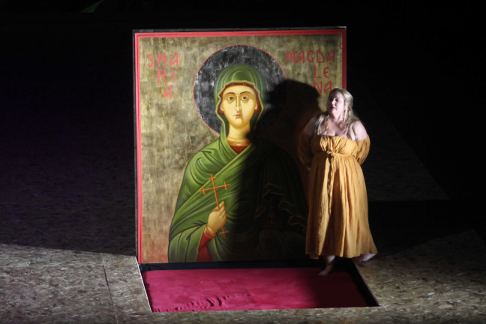 Catherine Hunold as Kundry with the seduction bed
Catherine Hunold as Kundry with the seduction bed
While Graham Vick’s theater is indeed essentially Brechtian, respecting an aim to make us think and learn, it also confronts us with blatant humanity using startling costumes — the loin cloth, wounded nudity of Amfortas, the loin cloth wounded nudity of his antithesis Klingor (the fit and muscular body of German bass baritone Thomas Gazheli), the hijāb covering of Kundry in the first act and the female chorus in the second act garden, the army fatigues and assault rifles of the knights of the grail, the pantsless knights of Klingsor’s sex obsessed kingdom.
Pure Brechtian theater rejects realism and its emotions but Graham Vick’s theater uses human bodies to create an intense sense of emotional space that heightens the realities we are forced to confront. His theater demands awesome numbers of human bodies to create these confrontations. Literally hundreds of bodies — a daunting demand fully met by the Teatro Massimo.
Of note in the Vick staging of Parsifal was the use of the half curtain as a shadow curtain in a direct quote of the silhouette processions that puppeteer William Kentridge often creates. The orchestral processions to the Holy Grail in the first and third acts were in Graham Vick’s world shadows of an endless line of a cruel and frivolous humanity marching across the vast stage expanse towards a meaningless grail. And yes, coup de théâtre, finally there was no grail at all!
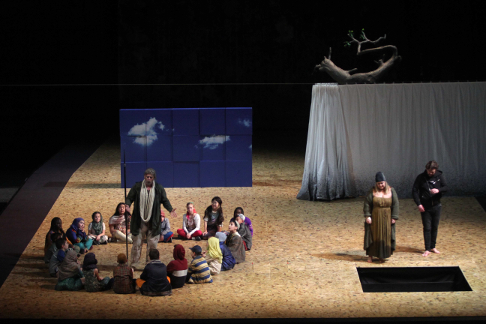 Gurnemanz among the children, Parsifal and Kundry
Gurnemanz among the children, Parsifal and Kundry
Cosima Wagner in her diaries quotes Wagner stating that Parsifal is “salvation to the savior” and the opera’s final music ascends towards somewhere for the more than five minutes of sublime orchestral music with offstage choir. But for Mr. Vick there there was no salvation of the savior — Amfortas had simply disappeared somewhere into the crowd.
The final tableau, in place of Wagner’s dove ascending to heaven while Amfortas and Kundry lay dead on the floor, was Parsifal sitting in the center of a circle of children wholesomely lecturing them about something profound while Kundry is beatifically standing nearby, liberated from Klingsorian aggression (a #MeToo moment), the impoverished knights of the grail now freed to pursue their personal destinies. One presumes that the throngs of humanity that populated Mr. Vick’s processions were now purified as well.
There were many electrifying moments to be sure, among them Amfortas digging out the buried grail (a tin cup), his blood falling into it to be drunk by the knights as they too mortified themselves. Kundry’s seduction of Parsifal held us entranced for its duration. And finally, astonishingly, as Parsifal baptized Kundry, a crowd of children were carried onto the stage holding huge building blocks (the voices of innocence that flooded the auditorium from time to time throughout the evening).
All this was a lot for maestro Amer Meir Wellber to hold together. But he succeeded in a reading that was absolutely straight forward, keeping to the tight timeline for each act that Richard Wagner had dictated (other conductors have loved to flaunt much slower times), thereby laying a solid foundation on which Graham Vick production might lay out his broader, social resolution. If the Italianate sound of the Teatro Massimo orchestra did not capture the philosophic raptures of the northern European spirit it did portray the enlivened spirit of the Mediterranean soul.
Among the many fine performances of the evening, some extraordinary (Tómas Tómasson as Amfortas and Thomas Gazheli as Klingsor), the magisterial Gurnemanz of Canadian bass baritone John Relyea stood out first as a young, emboldened knight, and finally as the old, wise voice of humanity. French soprano Catherine Hunold sang Mary Magdalene/Kundry in fine voice though without correspondence to a Wagnerian Venus.
The announced Parsifal of the production, Daniel Kirch, fell ill. His understudy Julian Hubbard stepped in for all six performances. Mr. Hubbard fully embodied Mr. Vick and Mo. Wellber’s Parsifal. If his fine, young voice served him exceedingly well for the first two acts, it did not possess the power and color to fulfill the heroic vocal demands of Wagner's third act Parsifal.
Michael Milenski
Production information:
Stage Director: Graham Vick; Scenery Timothy O'Brien; Costumes: Mauro Tinti; Choreography: Ron Howell; Lighting: Giuseppe Di Iorio. Chorus, childrens chorus, orchestra of the Teatro Comunale di Bologna. Teatro Comunale, January 28, 2020.
image=http://www.operatoday.com/Tomas%20Tomasson%20%28Amfortas%29%20%C2%A9Franco%20Lannino%20IMG_1738.png image_description=Tómas Tómasson as Amfortas [Photo by Franco Lannino courtesy of the Teatro Massimo] product=yes product_title=Parsifal in Palermo product_by=A review by Michael Milenski product_id=Above: Tómas Tómasson as AmfortasAll photos by Franco Lannino courtesy of the Teatro Massimo.
Vladimir Jurowski conducts a magnificent Siegfried
If the Ring operas which surround Siegfried are
monumental, or tragic, or in the case of Die Walküre even gloomy,
then Siegfried is designed as an heroic comedy. There isn’t really
a distinguishing line which suggests otherwise - scenes of farce abound,
Siegfried encounters obstacles which are edgily comic, there are scenes
where identity is never certain. In another sense it is a simple fairy tale
- a story about a boy who could not learn to fear intertwined with the
mythological stories of his youth and birth.
Siegfried is the only character who can really be said to make a journey
through the opera and it takes a singer of some stature to convince us that
happens. Unfortunately, Torsten Kerl wasn’t the man for it. There is only
so much slouching in chairs, hands in pockets, eyes screwing like pinballs,
and flaying of arms one can take - at the level we got it here, it did
little to convey the rowdiness of the early Siegfried. Even in Act III
where he should be moving into something more nuanced, Kerl seemed
unwilling to deviate from his earlier youth. His threats to Wotan missed by
a country mile, and “Das ist Kein Mann!” - that singular moment of great
epiphany for Siegfried - remained an illusion, a journey incomplete. Kerl
may have reached the summit of the mountain, and passed through the circle
of fire to awaken Brünnhilde - and achieved the last of his physical tests
- but this was a Siegfried who couldn’t exactly give us the shock or terror
- that learning of fear - which allowed him to awaken her and pledge his
love.
If Kerl’s Siegfried is shallow on depth, it would be unfair to suggest the
comedy isn’t there at all. His misfortune, however, was to have a Mime in
Adrian Thompson. I’m not sure I have seen any singer in a concert
performance bring such energy and sheer range to the character he is
portraying. Thompson’s skill isn’t to make us entirely forget that Mime is
fundamentally evil - though perhaps, we got rather more deviousness than
outright evil on this occasion. Thompson doesn’t exactly skimp on the
comedic elements of Mime, however. His constant whinging that he cannot
forge a new sword from the smashed fragments of Notung, his howls tempered
with groans are all emphasised. Unlike Kerl’s Siegfried who really doesn’t
act any of his comedy, Thompson simply revels in his. The danger with Mime
is that one risks us having sympathy for him and with Thompson it was
difficult not to do this. There was indeed something tragic, although it’s
highly comic too, when Mime transforms himself from failed forger into a
cook simply frying eggs. What was also so notable about Thompson’s Mime was
the quality of the singing. Here we had a tenor with clarion high notes and
a solid bottom register - a remarkably complete performance of the role.
The mystery of Siegfried is that its comedy masks a much darker
side. The balance between Mime’s humour and his true motives and
insidiousness is a thin one. Possessed by greed for the Ring, and his
deceit of Siegfried whom he has plotted to poison after he has killed
Fafner, it identifies him as a pantomime villain. It is something which
Adrian Thompson was able to beautifully master. Wotan, on the other hand,
is disguised as the Wanderer but given a crooked hat and an eye-patch to
add to his comedy, when this is largely unnatural for him. Evgeny Nikitin
was imposing in the role, a bass of majestic sweep and tone. His Act II
‘Riddle Scene’ with Mime was thrilling, lacking none of the narrator’s
theatricality which this scene often does. His renunciation in Act III had
overtones of tragedy and in his scene with Erda, Nitikin managed to sway us
into believing he was simply wiser. I’m a little unsure why the audience
seemed rather cool towards his performance - in many respects Nitikin
brought a fascination and complexity to the role. The ‘Riddle Scene’ - as
well as being beautifully sung - managed to combine the contradictions of
omnipotence and ordinariness with considerable deftness. Mime’s questions -
which are largely unknowable - trick the dwarf into a failure of
recognition. One could see the comic side of this, but both Thompson and
Nitikin layered it with effective skill.
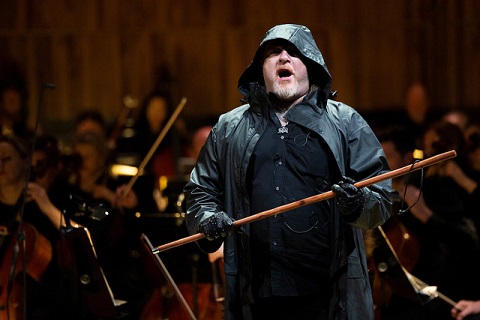 Evgeny Nikitin (Wanderer). Photo credit: Simon Jay Price.
Evgeny Nikitin (Wanderer). Photo credit: Simon Jay Price.
Fafner - literally, and somewhat appropriately as it happens given where
this dragon rests - was sung cavernously by Brindley Sherratt. For some
reason (heaven knows why) he was represented as a cobra. If his slaying
seemed more memorable for Sherratt’s voice and the power of the orchestra
than Kerl’s Siegfried, this was, I suppose, because the scene can seem like
farce. Only when Sherratt warned Siegfried of the treachery of Mime did it
seem to rise above that. Robert Hayward’s Alberich in his scene with Wotan
veered between submission and triumph, a polarity of power culminating in a
magnificent Curse. If Nitikin’s Wotan had the weight to tower over Hayward
in the early part of their scene Hayward would turn the balance to his
favour - the voice becoming dark and menacing.
Turning to the female roles, Alina Adamski’s Woodbird was slightly darker
in tone than one usually hears. The notes were there, almost in robust
fashion, but when compared to the rather small birds flying on the screen
behind her she seemed outsized. Anna Larsen’s Erda was majestic. There is,
of course, no comedy here and the richness and plushness of Larsen’s mezzo
betrayed all the seriousness of her earthiness.
Initially, Elena Pankratova’s Brünnhilde somewhat nerved me since it
appeared she needed a music stand for her very long scene with Siegfried -
and she did indeed flip pages here and there, though evidently she never
actually looked at them. But it was a distraction. Having said that, as
Brünnhilde wakes, which Pankratova managed with a certain amount of
tension, and hails the light - held with the penetrating sharpness of a
blazing ray from the sun - and asks who has awaken her, it becomes evident
that hers is a powerful and thrilling instrument. The notes are mostly
there (a high C astray once) this is a voice that rides effortlessly above
the orchestra. As she recalls Grane, her shield and her armour it is not so
much a literal reading of the libretto but a transfiguration of a soprano
who can bring meaning to them as we listen to her. If her Siegfried in
Torsten Kerl doesn’t exactly swell with the passion of their love,
Pankratova expresses the ardour of it with the freshness of someone who has
awakened to a new discovery. It’s the case of a soprano who effortlessly
soars her emotions and a heldentenor who struggles to express what he
feels.
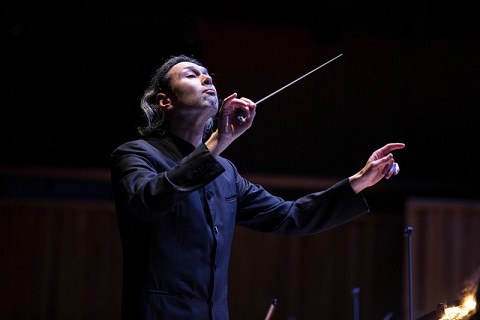 Vladimir Jurowski. Photo credit: Simon Jay Price.
Vladimir Jurowski. Photo credit: Simon Jay Price.
If this concert production really achieved a level of true greatness it was
provided by the London Philharmonic Orchestra and Vladimir Jurowski. The
playing of the orchestra was simply staggering. They opened the first act
in complete darkness, then a single light shining on the woodwind. Almost
the first thing one notices is that there are no risers (except for the
last desks of the violins) - a masterful stroke because the sound we get
from the orchestra is completely luminous, every phrase and detail crystal
clear. The sound that emerges from the double basses - arranged across the
back of the orchestra - is as full as you could want, even when playing at pianissimo. Jurowski’s tendency to linger - mostly during the
orchestral music - might be problematic, but it actually isn’t. The effect
is loving, as if he is caressing the score, teasing music from it, allowing
solos to emerge like voices. In every sense this is a true operatic
orchestra and Jurowski’s mastery of the score absolutely complete.
The opening of Act III might have felt slightly weightier, less visceral
than in some performances I have heard, but it swirled majestically - to an
accompanying Blitzkrieg on the screen behind the orchestra. Some of the
music during the Brünnhilde - Siegfried scene was charged with an erotic
intensity that recalled Tristan. Those magnificent tubas could be
grotesque, or they could be magnetically dramatic, plunging us into
orchestral bleakness. The Forest Bird music transitioned into literal
shapes rather than sounds; the heft of the brass and strings during the
Fafner motif was exhilarating. John Ryan’s principal horn, moving to the
front of the stage during Siegfried’s horn call, was a sublime reminder of
the quality of this orchestra.
A slightly underpowered hero aside, this was a magnificent Siegfried and bodes well for the complete cycle to be performed
next year.
Two complete concert stagings of
Der Ring des Niebelungen
will take place at the Royal Festival Hall between 25th-31 st January and 5th-10th February 2021.
Marc Bridle
Siegfried - Torsten Kerl, Wanderer - Evgeny Nitikin, Brünnhilde - Elena Pankratova, Mime - Adrian Thompson, Alberich - Robert Hayward, Fafner - Brindley Sherratt, Erda - Anna Larsen, Woodbird, Alina Adamski, Conductor - Vladimir Jurowski, London Philharmonic Orchestra
Royal Festival Hall, London; Saturday 1st February 2020.
image=http://www.operatoday.com/thomson%20and%20kerl.jpg image_description= product=yes product_title=Siegfried: Vladimir Juroswki conducts the London Philharmonic Orchestra at the Royal Festival Hall product_by=A review by Marc Bridle product_id=Above: Adrian Thomson (Mime) and Torsten Kerl (Siegfried)Photo credit: Simon Jay Price
I Capuleti e i Montecchi in Rome
Though to the vocal splendors of Romeo, 26 year old Russian mezzo-soprano Vasilisa Berzhanskaya, the Giulietta, 34 year old Italian soprano Mariangela Sicilia, and Tebaldo, 27 year old Peruvian tenor Iván Ayón Rivas we may add the splendors of Rome Opera’s excellent orchestra. The harp sang in splendid duet with Giulietta, the clarinet sang gloriously all on its own in an extended bel canto aria without words. Conductor Gatti and his orchestra were much more than accompaniment to the desperately beautiful outpourings of the protagonists, the orchestra penetrating the depths of their feelings in the musical delicacy of pristine Romanticism.
The passions that drive Bellini’s protagonists arise from difficult, usually impossible situations. Juliet of the Capuleti family falls in love with Romeo of the opposing Montecchi family. The resolution is in a most beautiful love duet. Finally Romeo believes Juliet dead, then Juliet knows that Romeo is dead. The resolutions are most beautiful arias.
Meanwhile all attempts at reconciliation of the factions are fruitless in some fine choruses. Poison was the usual Renaissance solution to many problems, and here its effect is far more than Juliet's death-like sleep. It precipitates the confrontation of Romeo with Tybald (Juliet’s intended) Romeo accusing Tybald of causing Juliet’s death, Tybald accepting the blame. No bloodshed here, the resolution is a most beautiful duet.
Bel canto is by nature virtuoso singing, since that is what bel canto operas are about. Thus bel canto operas on major stages are most often about famous singers. Rome Opera chose instead to use young singers in the early stages of their careers. It was a daring idea, pulled off by very accomplished, surprisingly accomplished young artists, and with the complicity of conductor Gatti.
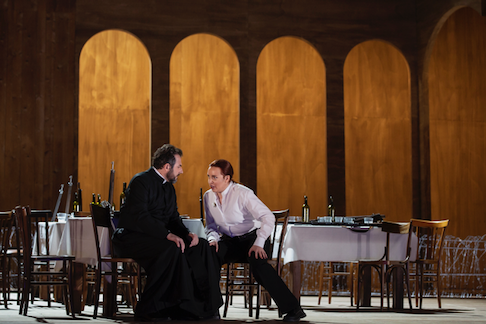 Nicola Ulivieri as Lorenzo, Vasilisa Berzhanskaya as Romeo
Nicola Ulivieri as Lorenzo, Vasilisa Berzhanskaya as Romeo
Conductor Gatti is known for the major repertory — Parsifal at Bayreuth, Elektra at the Met, Don Carlo at La Scala as examples, yet he found the ephemeral delicacy of this minor Bellini opera, and paternally supported the innocence of his young protagonists in their initiation into bel canto. These were not virtuoso displays of singing, rather there was the sense of these young artists discovering their musical feelings in voices as yet unmarked by established style and personality.
Soprano Mariangela Sicilia was the Teresa in Rome Opera’s 2016 Benvenuto Cellini (Berlioz) where her high notes were remarkable, but I noted some vocal uncertainties. Here there were no uncertainties whatsoever, the high notes still remarkable, more remarkable were the beautiful, extended pianissimos she exploited in her upper voice. Though to this point she has sung the standard light lyric roles there is now no doubt that bel canto is her inevitable destiny.
Mezzo soprano Vasilisa Berzhanskaya is a current protege of the Deutsche Oper Berlin where she has already sung Rosina in Il barbiere di Siviglia. She is a fully finished artist having survived the young artist programs at the Bolshoi, Aix-en-Provence and Pesaro. She possesses the necessary warmth of tone and agility of voice to portray the youthful Rossini roles to perfection, promising with maturity to reach for the heroic mezzo roles.
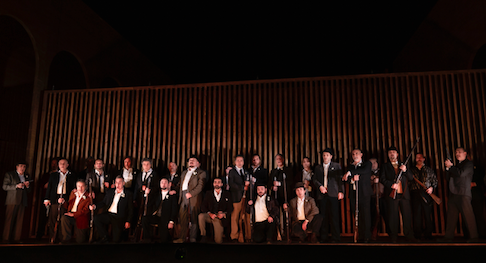 The Capuleti faction with rifles
The Capuleti faction with rifles
Tenor Iván Ayón Rivas has profited from training by Juan Diego Florez among other teachers in Peru. He has trained in Italy since 2014 and is in the first moments of his career. Of particular note is the evenness of his tone throughout the light lyric tenor register, and the ease with which he reaches and holds his high notes. As well the young tenor brings charming ingenue energy onto the stage.
Italian baritone Nicola Ulivieri sang Lorenzo, the family physician who imagined the machinations that resulted in the tragic deaths of the young lovers. Mr. Ulivieri has an established career on major stages and brought accomplished singing to this compassionate personage.
The new production was directed, designed and lighted by French/Italian stage director Denis Krief, a long time resident of Rome. His setting was highly abstracted shapes that moved efficiently, costumes were contemporary street dress. His lighting was of some sophistication resulting at times in effective stage pictures, notably the exquisite death tableau. What I found missing was a real context for the sophisticated conducting and the brilliant, youthful singing of this rarely performed opera.
Michael Milenski
Cast and production information:
Romeo: Vasilisa Berzhanskaya; Giulietta: Mariangela Sicilia; Tebaldo: Iván Ayón Rivas; Lorenzo: Nicola Ulivieri; Capellio: Alessio Cacciamani. Orchestra and Chorus of the Teatro dell’Opera di Roma. Conductor: Daniele Gatti; Stage direction, scenery, costumes, lights: Denis Krief. Teatro dell’Opera, Rome, January 23, 2020.
image=http://www.operatoday.com/Capuleti_Rome1.png
product=yes
product_title=I Capuleti e i Montecchi in Rome
product_by=A review by Michael Milenski
product_id=Above: Mariangela Sicilia as Giulietta, Vasilisa Berzhanskaya as Romeo [All photos courtesy of the Teatro dell'Opera di Roma]
February 1, 2020
Santtu-Matias Rouvali makes versatile debut with the Royal Concertgebouw Orchestra
At his debut with the Royal Concertgebouw Orchestra he displayed an effortless flexibility, being equally at home in the unfettered sweep of Italian Romantic opera and the stringent rhythmicity of Stravinsky’s neoclassical opera-oratorio Oedipus Rex. “Inexorable Fate” was the theme linking the three items on the programme, and the first two also turned out to share several musical elements.
Rouvali conducts with panache, his arms drawing graceful curves in the air, as he punctuates the music cleanly with small flourishes of his baton. After the opening chords ushered in the inescapable destiny of the title, the overture to Verdi’s La forza del destino took off with refreshing buoyancy. Rouvali kept the details crisp and the tone brilliant even at the swiftest of prestos. He applied the same care in the phrasing of Ariadne, the last composition by Theo Verbey, who died unexpectedly last October, conceived as a companion piece to the Stravinsky. Unlike Oedipus’s unsuccessful efforts to escape the prophecy that he will kill his father and marry his mother, Ariadne manages to outsmart the labyrinth of fate by giving Theseus, slayer of the Minotaur, a ball of thread that guides him out of the maze. Lasting around twenty minutes, Ariadne, like Verdi’s overture, combines transparent lyricism with dramatic progression. Starting out with fragile flute figures, it swells to include the full complement of strings. When the whole range of the brass comes in with a driving motif, there is sinister menace. The piece constantly changes colour and texture, making use of the whole orchestra. Before all the sections unite for a final restrained crescendo, an ethereal violin solo rises, haloed by a harp. Although Verbey didn’t describe the work programmatically, it was easy to imagine the Cretan princess’s thread unwinding in the woodwinds and the rumbling monster charging in the horns. Ariadne is a highly gratifying swansong and the RCO gave it a lustrous world premiere.
They carried over that burnished sound to Oedipus Rex, with its starring roles for the sinuous clarinet solo, bulldozing brass and its main motor, the pummelling percussion. Rouvali’s reading was dynamically exciting and extremely polished, maybe a tad too polished for the more savage moments. A little snorting raucousness in the fanfares wouldn’t have been out of place, but one can’t really cavil about such a fine interpretation, which also boasted a superlative choir. The choir in Oedipus Rex is a dominating presence and acts as a Greek chorus. The men of the Latvian State Choir were not only technically impeccable, but got every mood and nuance right—the magnificent bombast of the royal ovations, the gossipy whispers and the terrible deluge with which they pronounce Oedipus the foulest of monsters before they send him away with a tender farewell. The work reached its dramatic peak in their scene with the Messenger and the Shepherd, sterlingly sung by bass-baritone Christian Van Horn and tenor Attilio Glaser. Van Horn was also a vocally imposing, dangerous-sounding Creon. Bass-baritone Shenyang emitted gravitas as the prophet Tiresias, spitting out ominous consonants when Oedipus enrages him into disclosure.
In the spirit of the formalistic nature of the work, director Gijs de Lange had the soloists, whose faces were painted with white masks, standing stiff, moving only their arms in stylized gestures. This worked for Van Horn, Glaser and Shenyang, who all benefited from singing downstage. Tenor Lance Ryan, however, was not helped by being sent behind the orchestra when his curiously expressionless Oedipus starts to piece the horrific revelations together. The same applied to a certain extent to soprano Anna Caterina Antonacci, who, after a vocally unstable start, sang a warm and textually focused Jocasta. Pity about her physical remoteness behind the double basses. The decision not to subtitle the Latin text was a mistake. While De Lange’s wish to maintain audience detachment was a valid one, subtitles would have been a boon to those unfamiliar with the work. Stravinsky himself built in enough alienating features, exploiting ritualistic repetition and incongruity between text and music, as when he set the description of Oedipus’s self-blinding as a rowdy drinking chorus. Paradoxically, actor Pierre Bokma, unlike most of his predecessors, stayed away from stagey declamation and chose to deliver the Dutch narration naturalistically, as if talking to a camera. Whether or not this was a conscious choice, it was the most alienating effect of all.
Jenny Camilleri
Igor Stravinsky: Oedipus Rex
Theo Verbey: Ariadne (World Premiere)
Giuseppe Verdi: Overture to La forza del destino
Lance Ryan (tenor), Oedipus; Anna Caterina Antonacci (soprano), Jocasta; Christian Van Horn (bass-baritone), Creon/Messenger; Shenyang (bass-baritone), Tiresias: Attilio Glaser (tenor), Shepherd; Pierre Bokma, Narrator. Gijs de Lange, Mise-en-espace. Santtu-Matias Rouvali, Conductor. Latvian State Choir. Royal Concertgebouw Orchestra. Heard at the Concertgebouw, Amsterdam, on Thursday, the 30th of January, 2020.
image=http://www.operatoday.com/Santtu-Matias%20Rouvali%20High%20Res%204%20-%20credit%20Kaapo%20Kamu.png image_description=Santtu-Matias Rouvali [Photo by Kaapo Kamu] product=yes product_title=Santtu-Matias Rouvali makes versatile debut with the Royal Concertgebouw Orchestra product_by=A review by Jenny Camilleri product_id=Above: Santtu-Matias Rouvali [Photo by Kaapo Kamu]Tristan und Isolde in Bologna
Gossip has it that Bologna’s 1871 Lohengrin was the first Wagner opera to be heard in Italy because Giuseppe Verdi did not engage the Teatro Comunale’s principle conductor Angelo Mariani to conduct the premiere of Aida in Cairo, and furthermore that Verdi had encouraged star soprano Teresa Stolz, Mariani’s lover, to leave him. Thus Mariani wreaked revenge on Verdi by bringing Verdi’s archival into Italy! Verdi did attend one of the performances of Lohengrin, and later wrote to his publisher that it made him want to throw up. It is rumored that Teresa Stolz then became Verdi’s mistress.
Tannhauser was programmed in Bologna the following year, 1872 the year Wagner accepted honorary citizenship of Bologna! Rienzi came in 1876 and Dutchman in 1877. The Teatro Comunale gave the Italian premiere of Tristan und Isolde in 1888. This 2020 production of Tristan is the twelfth in the Teatro Comunale’s history. The stage director of the 1983 third last version situated the opera in the Otto Wesendonk living room [his wife Mathilde a Wagner lover and muse], stage director Ruth Berghaus set the 1996 penultimate version on a space station.
Surely taken right in stride by the Bolognese this 2020 version occurs within a work of art, an installation that surely would be most at home in hip, chic, intellectual Berlin. Stage director Ralf Pleger and his designer Alexander Polzin are numbingly credentialed within the film/art/opera avant-garde establishment.
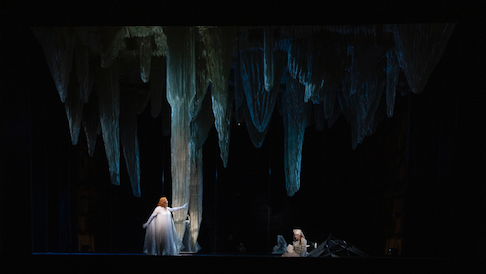 Act I
Act I
The first act was in a maze of slowly, very slowly descending stalactites that illuminated, lightning-like, from within at that crucial moment, the second act was a huge revolving tumbleweed-like sculpture from which oozed white worms (dancers) in crucial moments in Wagner's love death enactment. The third act was a highly abstracted starry sky back wall that in the considerable magic of the lighting effected by John Torres sometimes appeared as a ceiling that was a floor, and at that crucial moment the wall moved in toto, somehow, startlingly forward.
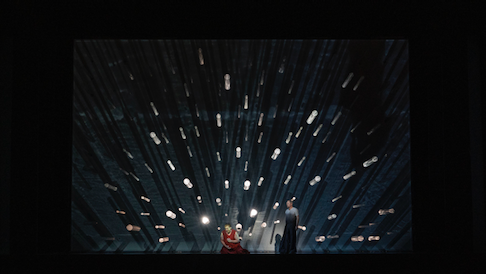 Act III
Act III
There was no action. No one drank the magic potion, the lovers never touched much less looked at one another except in rare, very rare strategic moments, Isolde did not even glance at the dead Tristan, Melot’s spear did not wound Tristan or kill Kurvenal. There was no action. None.
It was spectacular, never mind whatever philosophical underpinnings or artistic intuitions one may conjure (director Pleger suggests it as a drug trip). It was abstract art as image in music. It was not drama in music.
Musically Wagner’s opera soared within these images, conductor Valčuha finding surpassing warmth and an astounding intimacy from the Teatro Comunale’s splendid orchestra, the winds and brasses singing in tones of purest color, the tempos in spontaneous and natural unison with the text declamation and the progression of images. There was no drama, no musical trauma in Mo. Valčuha’s exposition of this Wagnerian rite.
German tenor Stefab Vinke was Tristan. Mr. Vinke began as a light lyric dramatic tenor (jugendlicher heldontenor), later adding all the Wagner heldon tenor roles to his repertoire. It was reported that he tired though the trials of Siegfried in the recent Metropolitan Opera Ring, and here there seemed to be a moment of distress in the second act love duet. But for the murderous third act monologue he was in superb voice to his death, riveting us as an image of wounded suffering in a red tunic, finally trailed by six dancers in red tunics to create a swirling red line.
King Mark was sung by German bass baritone Albert Dohmen, a formidable Bayreuth Wotan. Of imposing presence Mr. Dohmen stated the case of the betrayed king in absolute clarity and exquisite dignity, adding occasional portamento (sliding tone) in his attack of a phrase to startling vocal effect. Russian mezzo soprano Ekaterina Gubanova provided the Brangāne in gorgeous, present voice throughout, her second act warning ”Einsam wachend in der Nacht” was one of the evening’s most beautiful moments as she hung on the turning sculpture bathed in golden light. Tristan’s squire Kurvenal was sung by German baritone Martin Gantner who infused his sympathetic evening-long presence with Tristan in warmly focused voice.
The production’s Isolde was 54 year-old Danish soprano Ann Petersen. Mme Petersen produces a mighty tone that she manages with little nuance. She is an accomplished veteran of the role and thus delivered a performance that was generic though sufficient for us to understand and enjoy composer Wagner and stage director Pleger’s intentions.
Michael Milenski
Cast and production information:
Tristan: Stefan Vinke; Isolde: Ann Petersen; King Mark: Albert Dohmen; Kurwenal: Martin Gantner; Brangäne: Ekaterinburg Gubanova; Melot: Tommaso Caramia; Shepherd: Klodjan Kaçani. Chorus and orchestra of Teatro Comunale di Bologna. Conductor: Jura Valčuha; Stage Director: Ralf Pleger; Scenery: Alexander Polzin; Costumes: Wojciech Dziedzic; Lights: John Torres/Kate Bashore; Choreography: Fernando Melo. Teatro Comunale di Bologna, January 26, 2020.
image=http://www.operatoday.com/Tristan_Bologna1.png
image_description=Photo by Christian Dresse courtesy of the Opéra de Marseille
product=yes
product_title=Tristan und Isolde in Bologna
product_by=A review by Michael Milenski
product_id=Above: Isolde, Act II
All photos by Rocco Casaluci courtesy of the Teatro Comunale di Bologna.